SEWING WIZARD TRAINING: Sewing Patterns 101
Sewing patterns are powerful tools in a sewing wizard's inventory.
Using sewing patterns to make your own apparel opens up an entire world of possibilities that you would never get just shopping at the store – both for costumes and regular clothes!
Here’s what you’ll learn in this lesson:
- Advantages of sewing patterns (as opposed to ready-made clothing)
- Common sizing labels, what they mean ... and how they changed
- What wearing ease is, and why it's important
- How to find and interpret the pattern information you need
- How to properly orient the pattern piece on the fabric BEFORE cutting
- FIVE different ways to cut your pattern pieces, and which one I recommend
- How NOT to use sewing patterns (courtesy of my assistant, Yogurt)
Sewing Wizard Newsletter
Subscribe for more FREE sewing lessons, announcements, special offers, and more!
Your contact information is safe with us! Here is our privacy policy.
What is a Sewing Pattern?
A sewing pattern is basically a template for a garment (like blueprints) that usually comes in some kind of envelope, along with instructions for how to make it.
There are patterns for just about anything you can imagine … “normal” clothes like shirts, dresses, jeans, skirts, underwear:
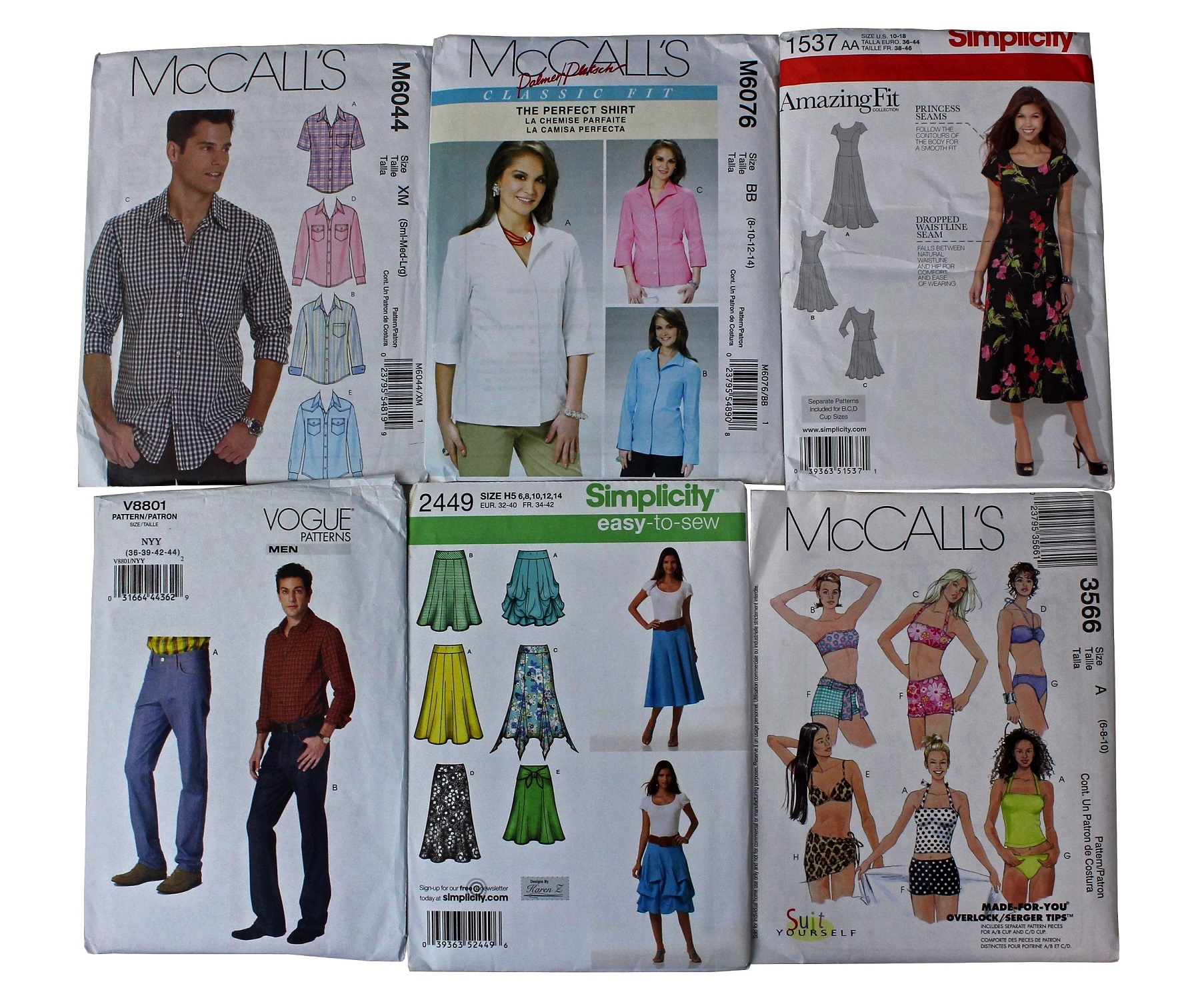
Fancy garments like suits, tuxedos, and dress pants:
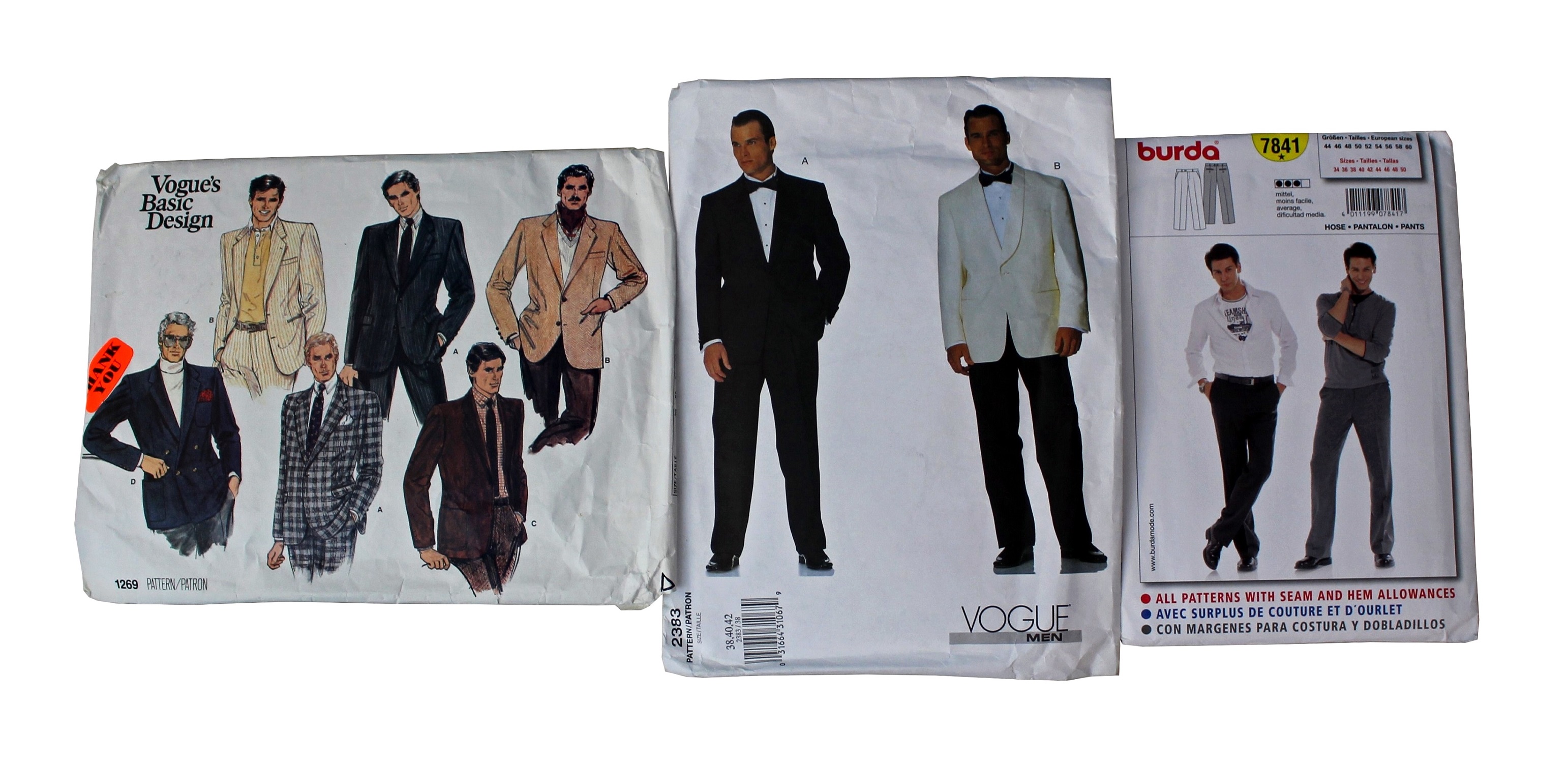
And of course all kinds of costumes, from Renaissance-y dresses and tunics to Victorian frock coats …
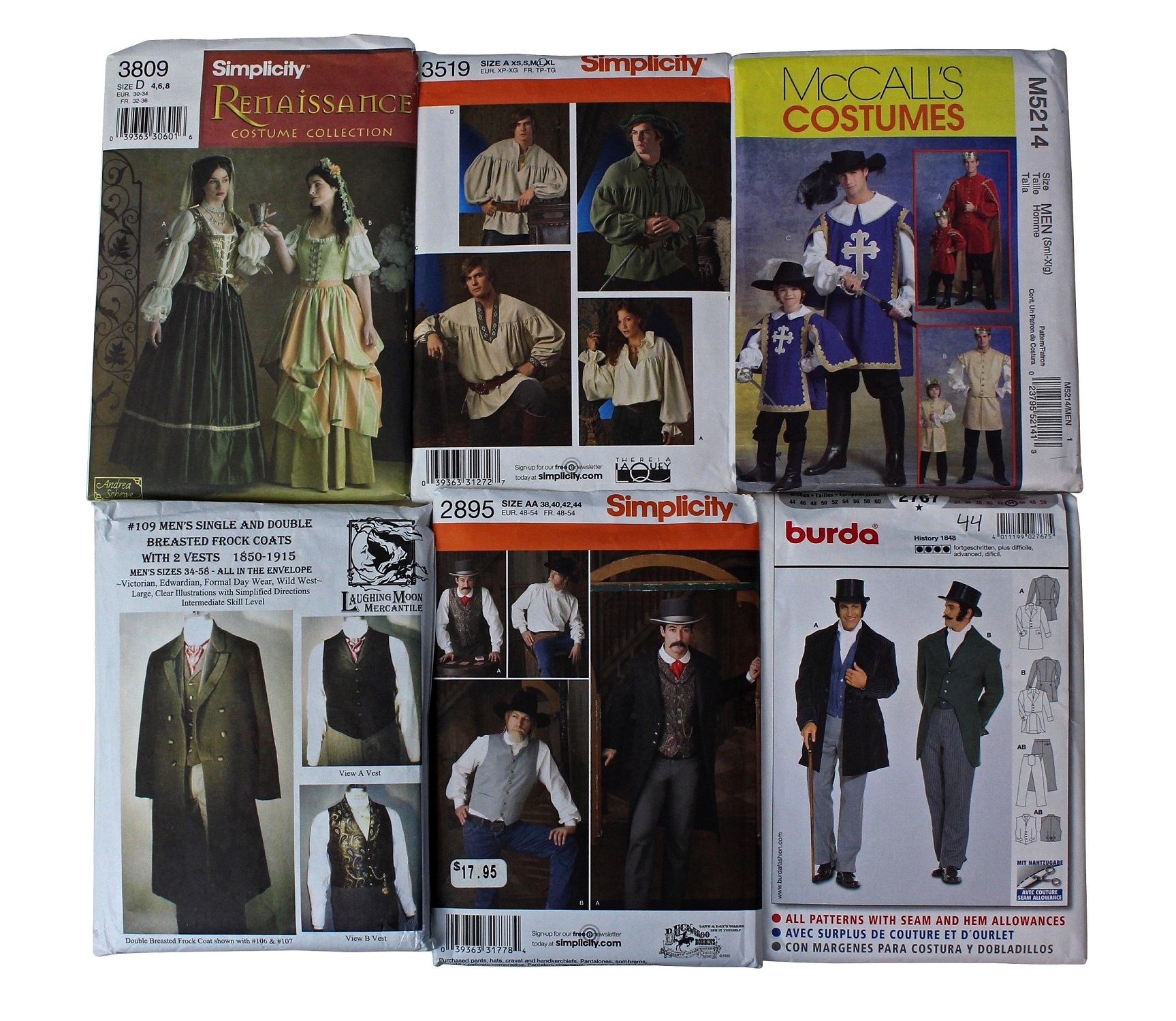
From colonial and Civil War to pirates, Christmas, and holidays …
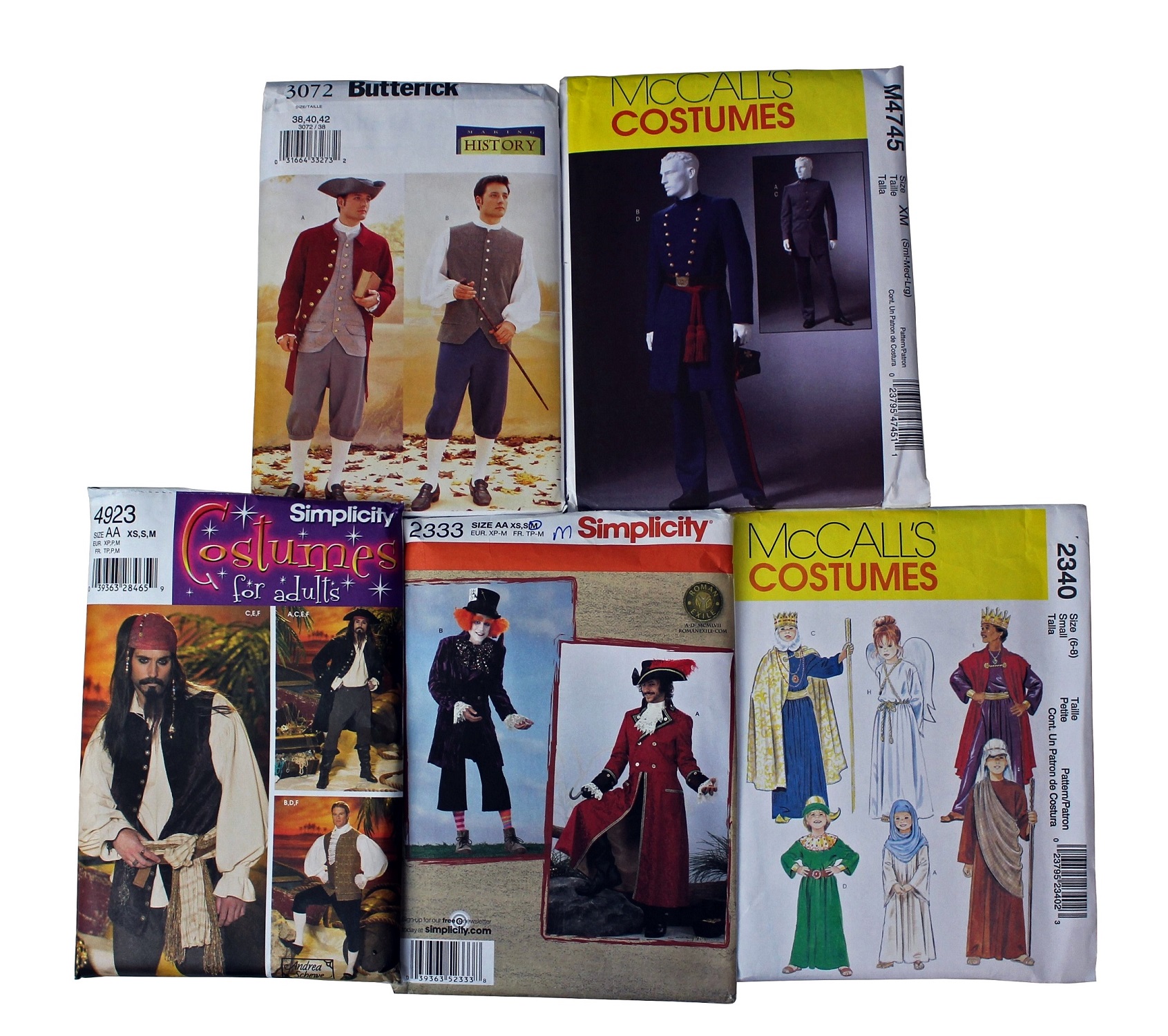
Medieval fantasy …
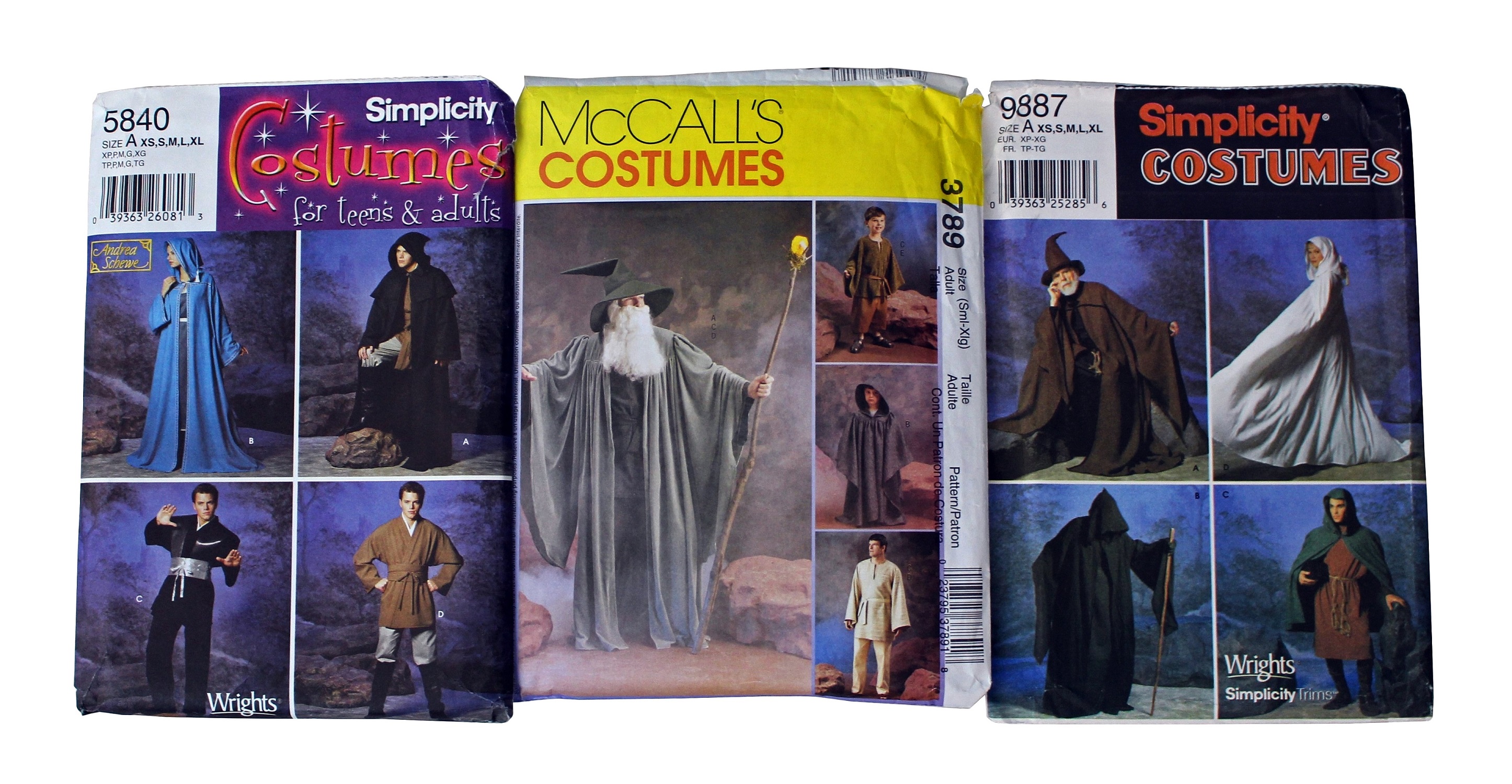
Capes and cloaks galore!
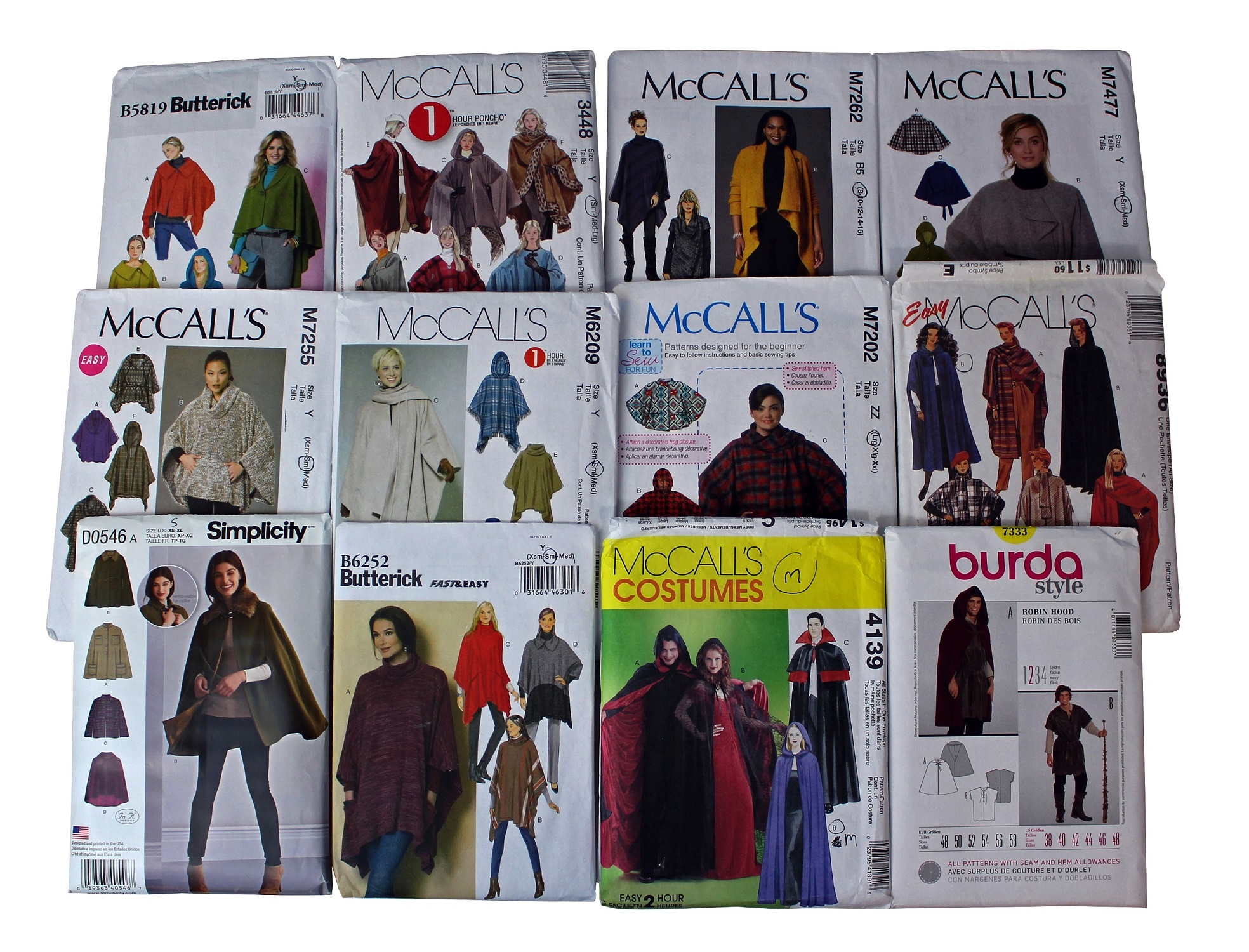
Plus many patterns based on shows and movies …
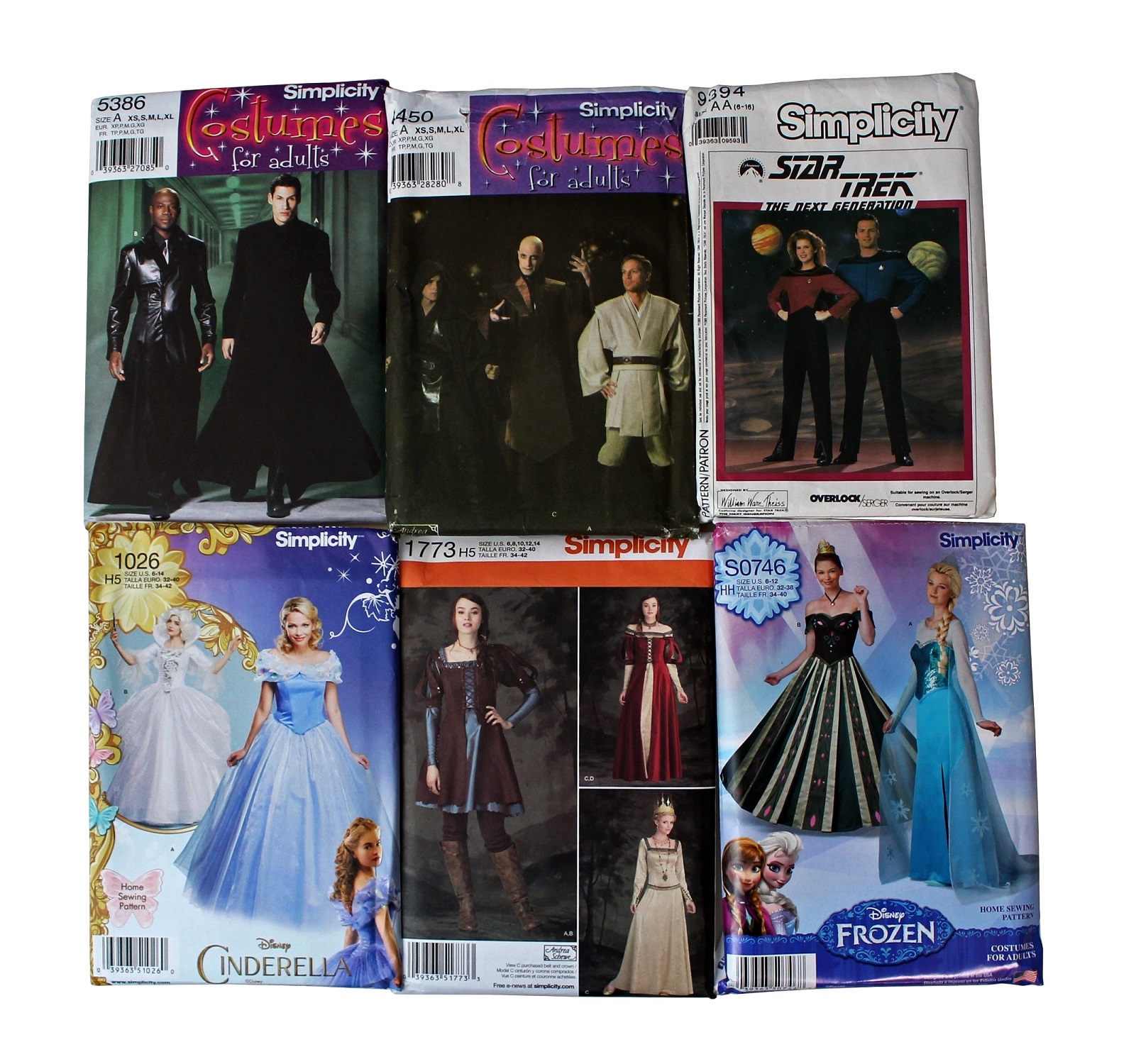
The selection is huge!
But that’s just the beginning …
Perhaps you’re familiar with the disappointment of shopping and finding something you really liked, but was unavailable in your size?
Well sewing patterns are usually available in multiple sizes, so you just pick the size you want and go for it!
And if it doesn’t quite fit right, you can do whatever you need to – take it in a bit here, let it out a bit there, make it longer, make it shorter, whatever you need to do.
The end result is something that should fit you perfectly.
Or maybe you’ve had this experience: you found something (like a shirt) that you really liked and it was a perfect fit, but it wasn’t available in a color you wanted.
Well when you use a sewing pattern, you not only get to choose the garment, the style, and the size, but you also get to pick the fabric, too – as well as any buttons or trim it might need!
Sewing patterns really give you a lot of options you wouldn’t otherwise have, and they give you a chance to express yourself, and your creativity.
What's Included in the Pattern
On the pattern envelope, there’s usually a drawing or photo of whatever garment(s) the pattern is for.
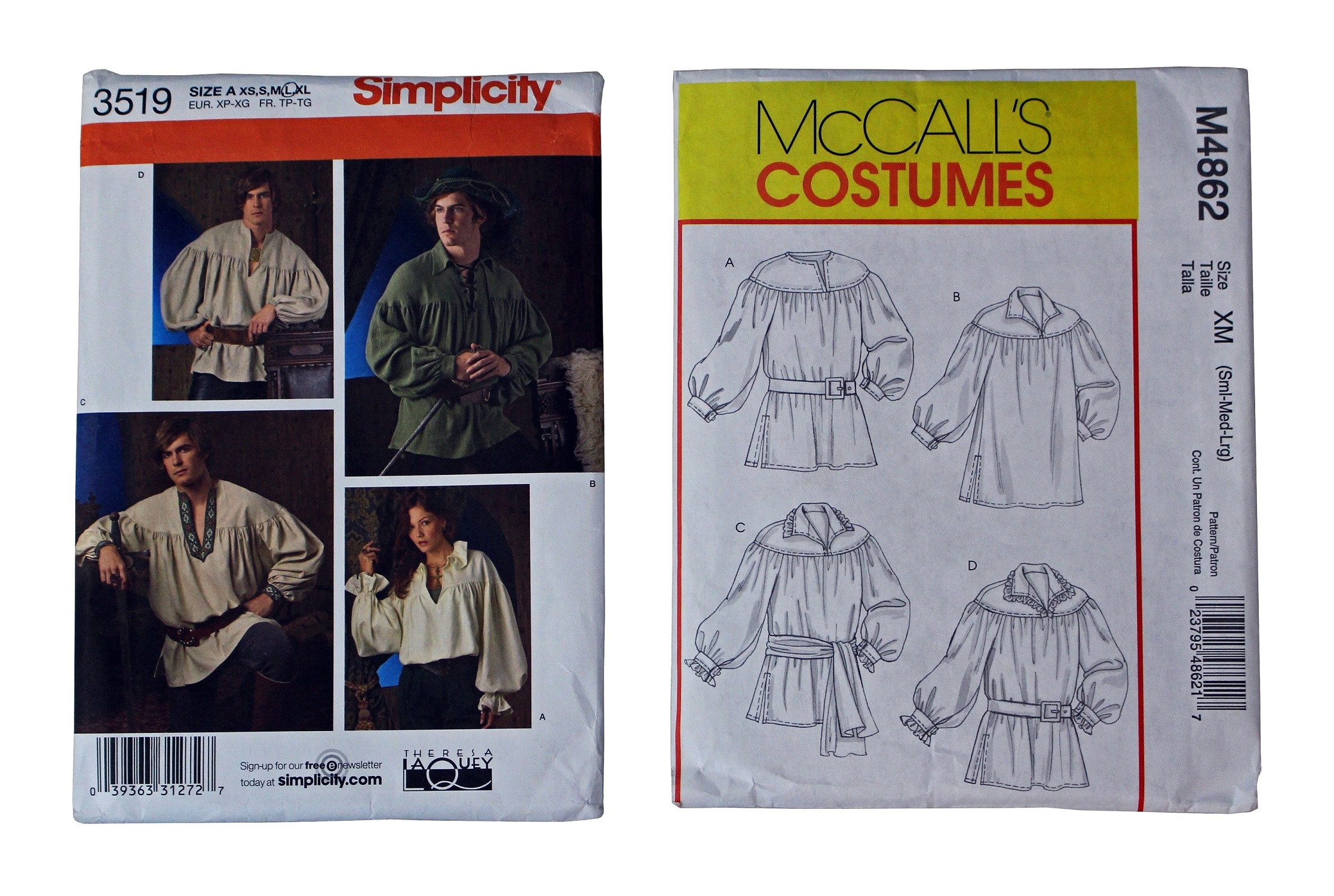
Some have labels too, but you can usually get a good idea just by looking at the picture.
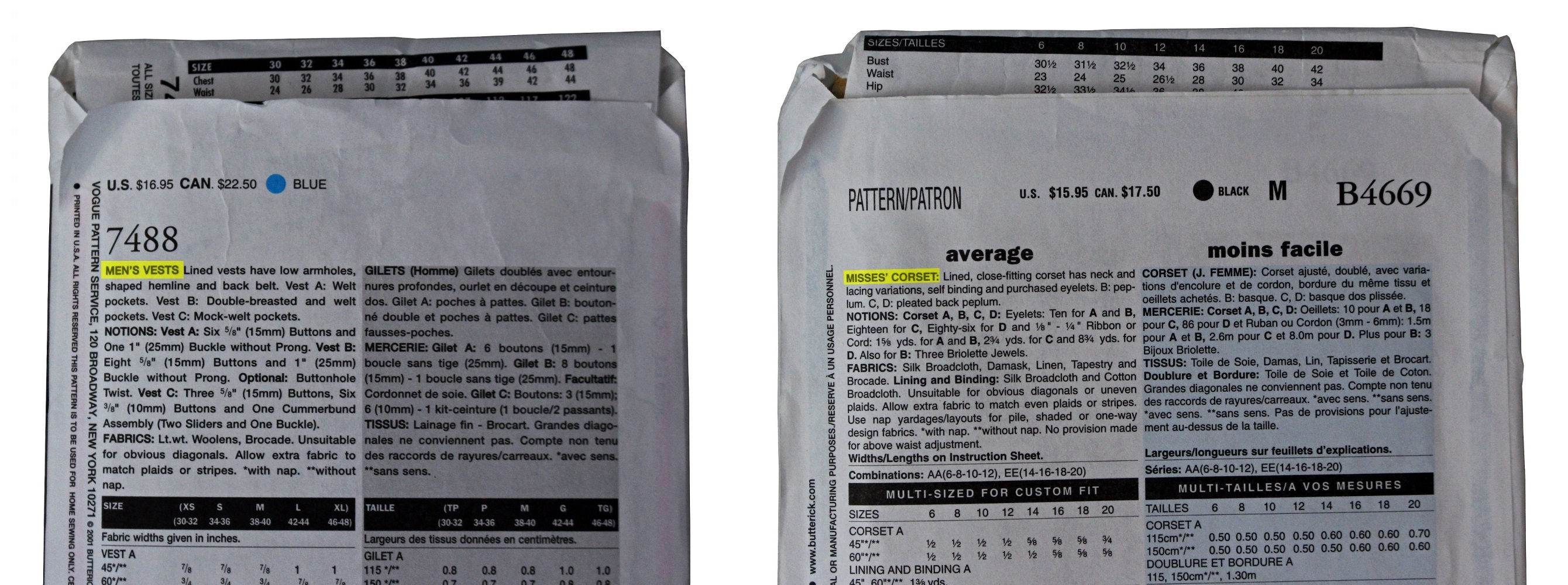
Some patterns include multiple garments.
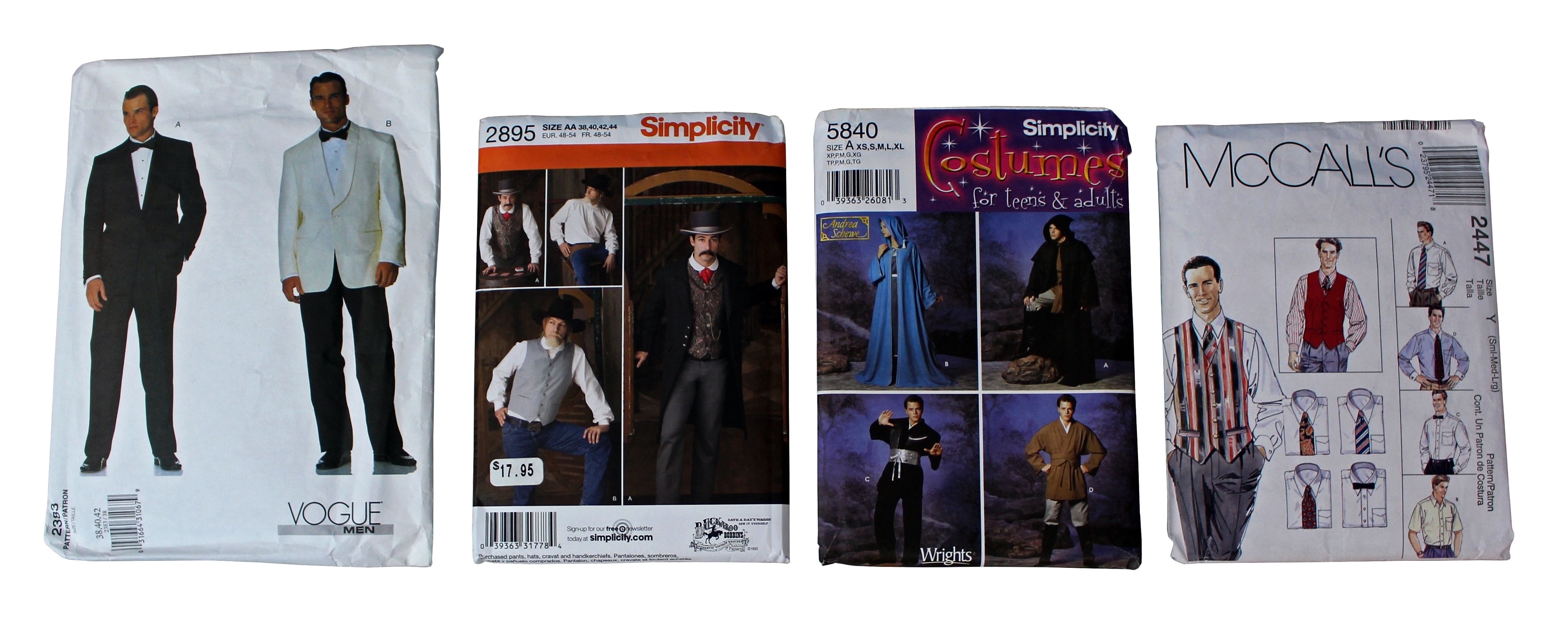
And some patterns include multiple styles of the same garment.
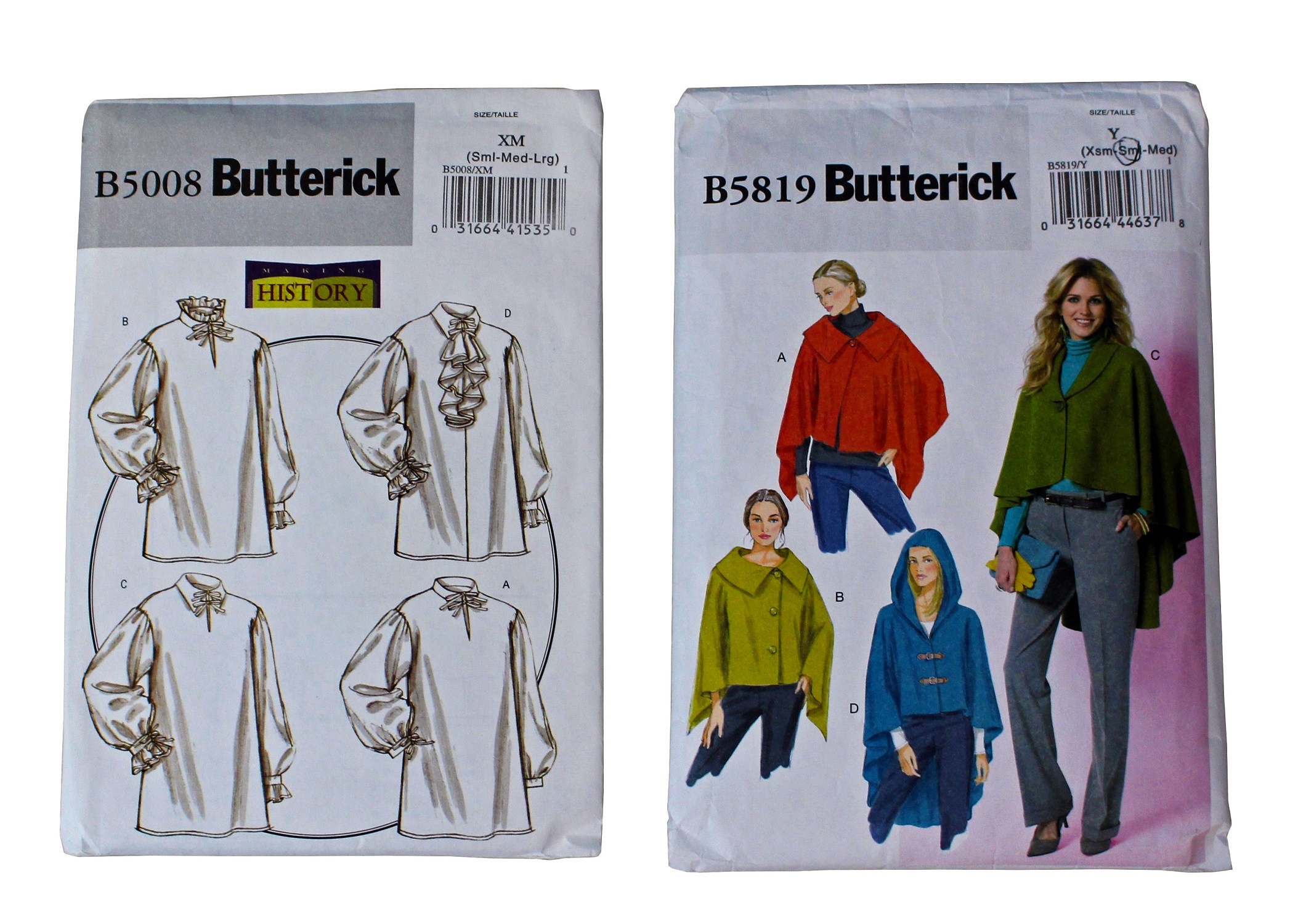
Choosing Your Size
Usually the included size(s) are labeled on the front.
Sometimes they’re numeric – women’s 6, 8, 10, 12, etc. and men’s 38, 40, 42, 44, etc.
Sometimes they’re simply small, medium, large, extra-large, etc.
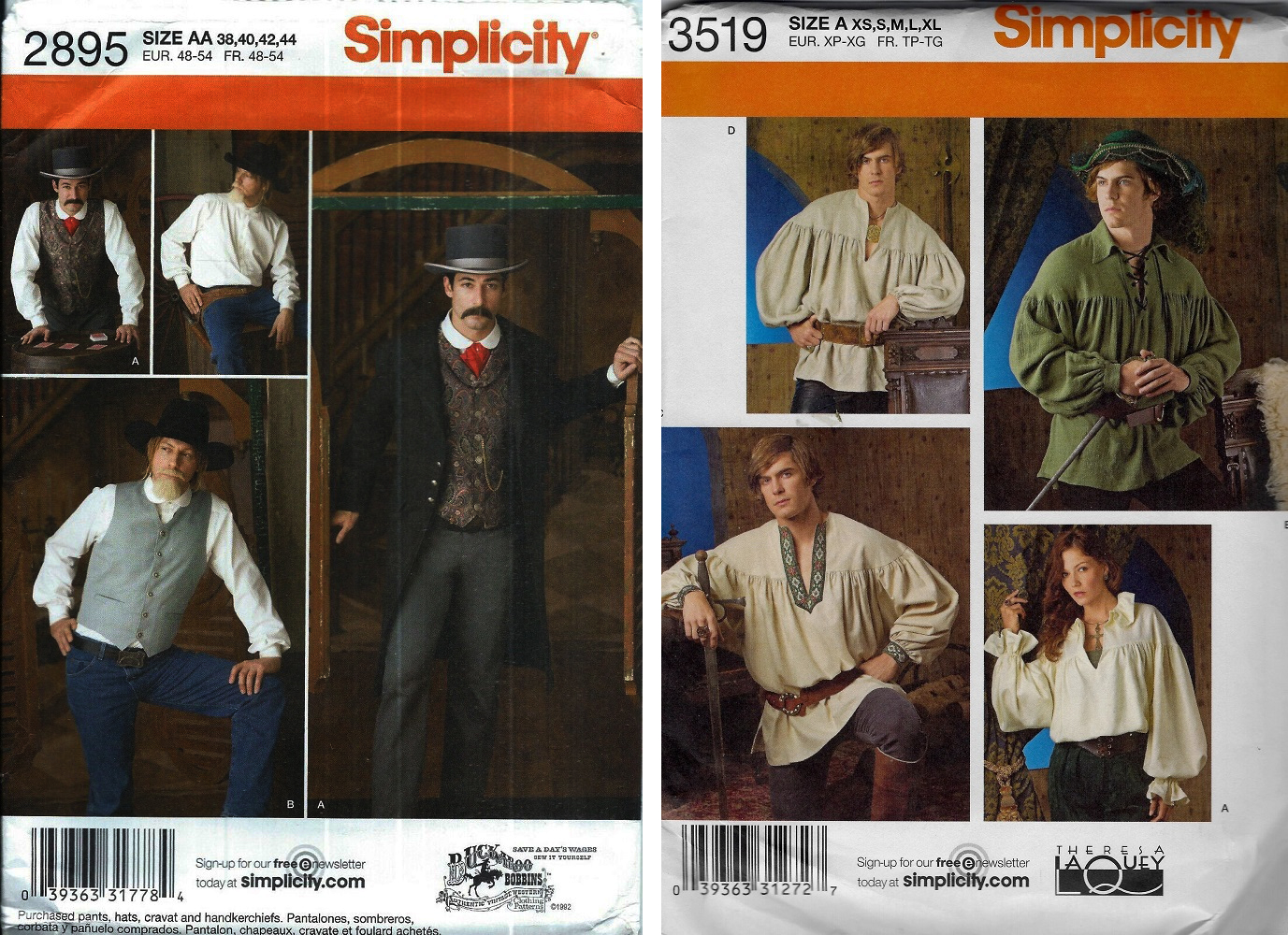
There are a few different issues to contend with, regarding sizing – mostly for women.
Not only are women’s sewing pattern sizes not the same as those (allegedly same) garment sizes from retail stores, but women’s pattern sizes actually changed a few decades or so ago.
For example, a women’s size 14 sewing pattern from the 1970s is not the same as a modern women’s size 14 pattern, and neither of these are the same as a size 14 garment that you’d get at a retail store … or so I’m told. (Thankfully, I haven’t had to deal with this.)
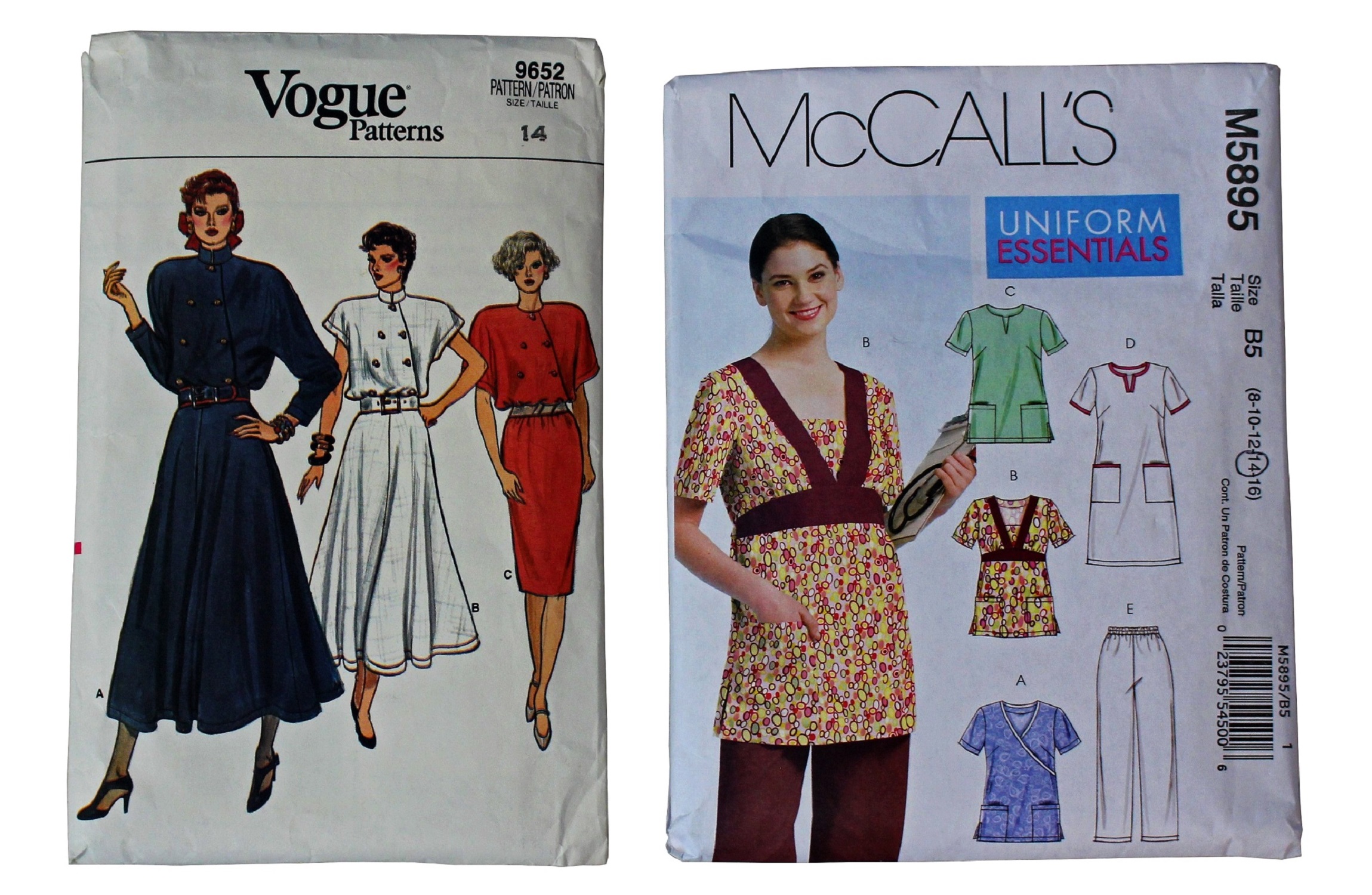
Men, our system’s great – and it’s easy! Numeric sizing, based on your measurements.
If you have a 42” chest, you probably wear a size 42 jacket.
If you have a 34” waist, you probably wear size 34 pants.
Upper garments are based on the chest measurement, and the lower garments are based on the waist.
You can mix-and-match, too – say, a size 38 chest but a size 40 waist.
And you can get more specific; “size 44 long” tells you just about everything you need to know, at least to start.
Someone saying, “I’m a women’s size 12 bust, size 10 waist, and size 14 hips” tells you nothing.
(I don’t know who invented this system or what they were thinking, but I’m sorry, ladies. Nobody asked me.)
So I suggest choosing your size based on the garment’s finished measurements, which we’ll get to shortly.
But men, there is one thing to watch out for:
Normally patterns for pants, trousers, slacks, jeans, and shorts are based on the waist measurement, like I mentioned above.
However, if your pattern includes both upper and lower garments (such as a suit pattern or a uniform that includes jacket and trousers), everything will probably be based on the chest measurement.
In other words, the pants that come with a size 38 suit are probably not the same as size 38 pants.
Older sewing patterns usually only included one size per envelope, but modern patterns usually include multiple sizes in the same envelope – sometimes even all the available sizes, which is very convenient.
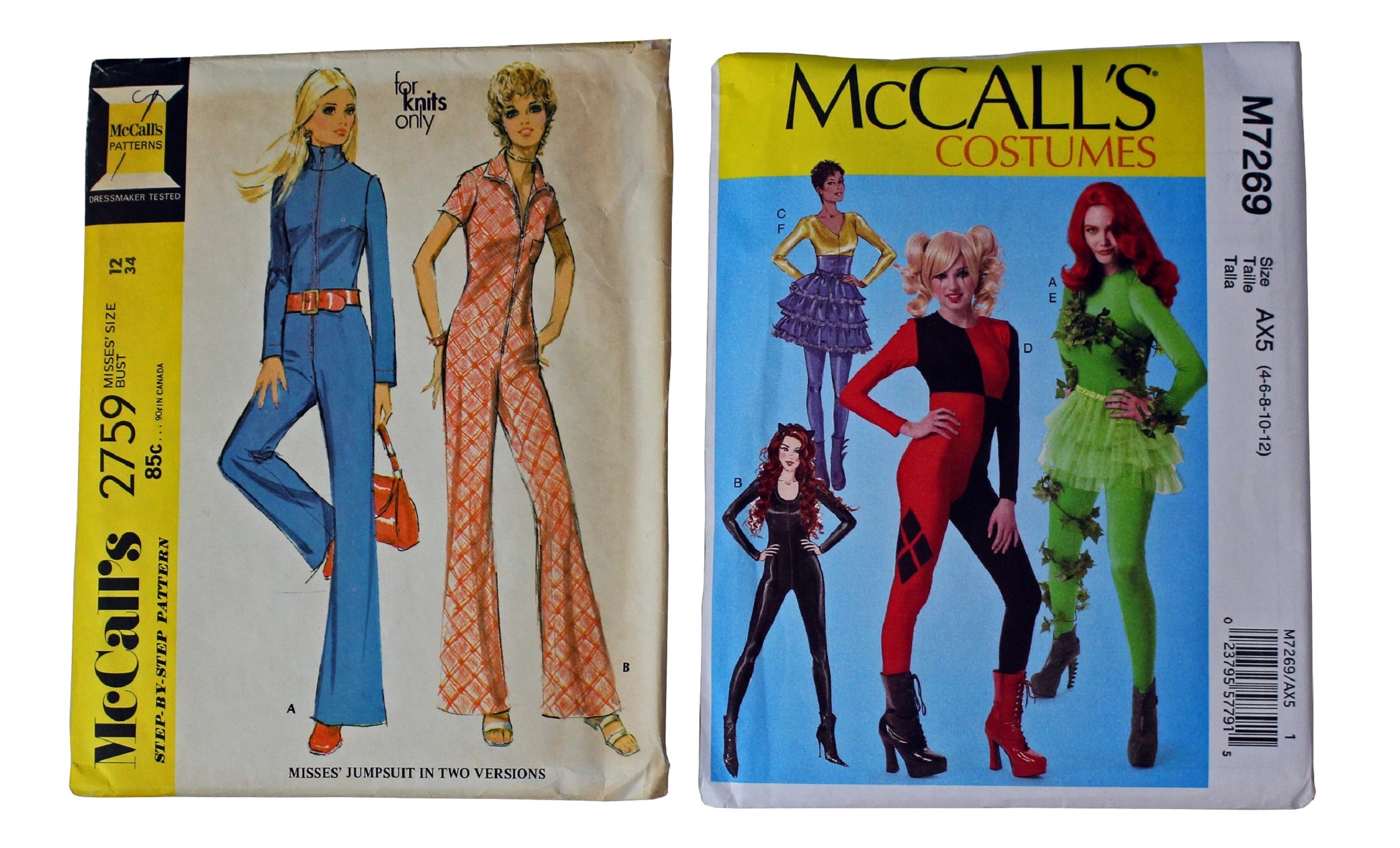
Required Materials
Flip the pattern envelope over, and you can see they’ve provided you with some very helpful information.
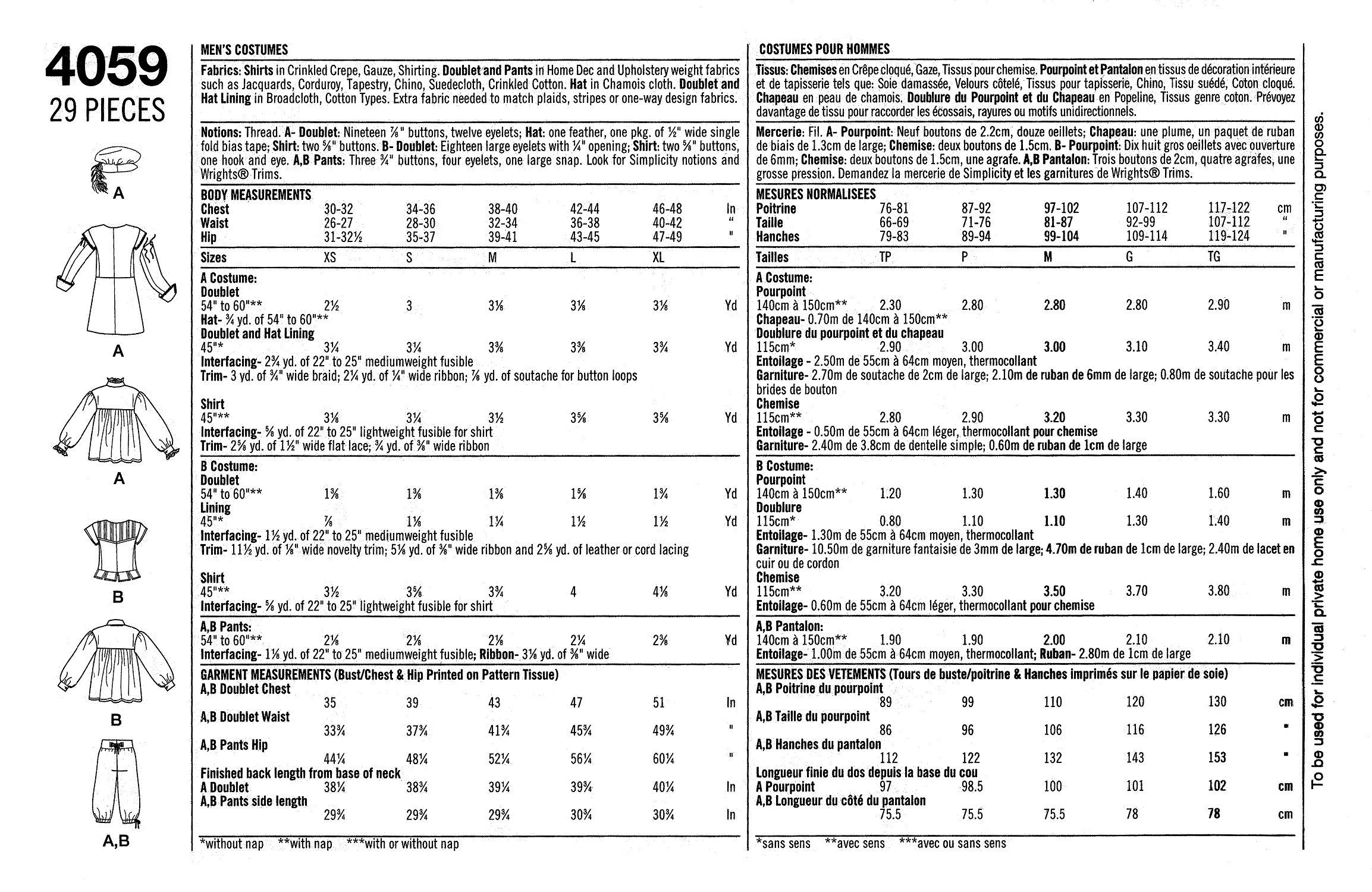
Most of it is pretty self-explanatory, but it can seem kind of overwhelming at first, so we'll go through it together.
On the left are usually some drawings of the garment(s) that the pattern includes.
Sometimes they’ll have front and back, but sometimes they might just have one or the other.
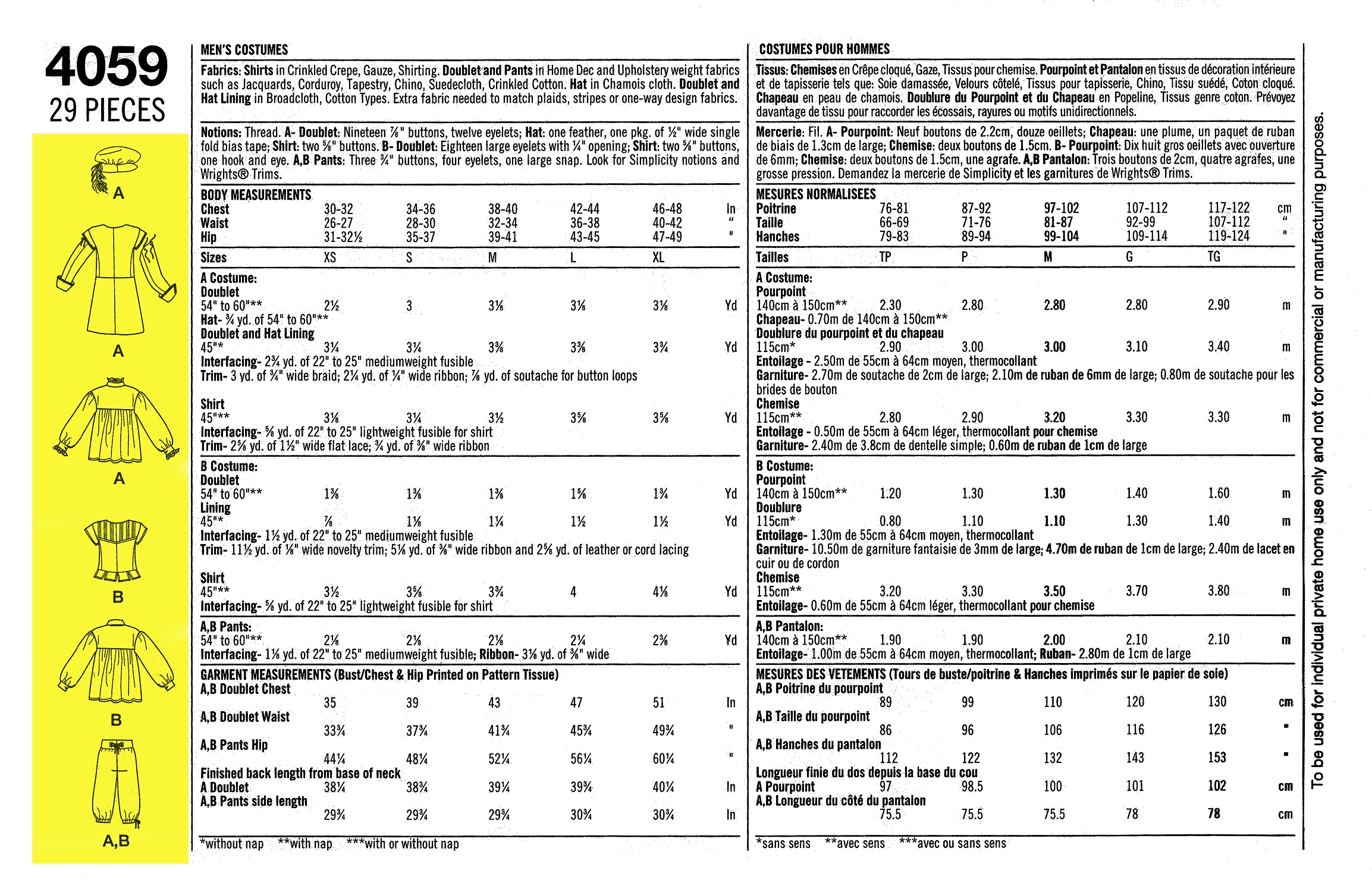
At the top are some recommended fabrics for use with this pattern.
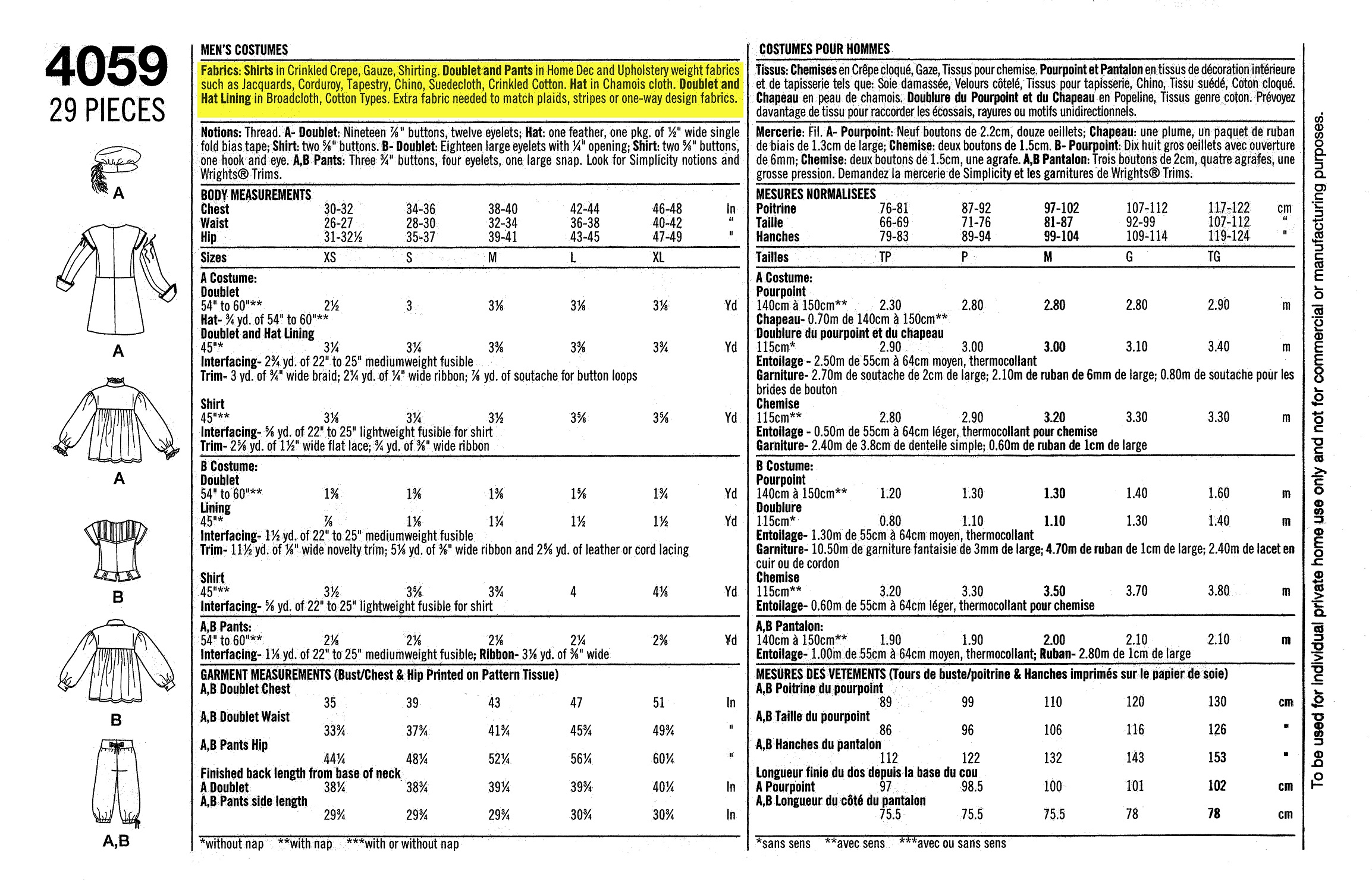
It’s up to you if you want to use any of these, or if you want to try something else, but keep in mind they designed with this pattern with certain fabrics in mind and have probably used it more than you have, so you definitely want to at least strongly consider their recommendations.
However, sometimes they’ll clearly state restrictions like, “This is for stretch fabrics only,” or, “Not suitable for plaids,” so watch for that.
Beneath the required fabrics are the “notions” you’re going to need.
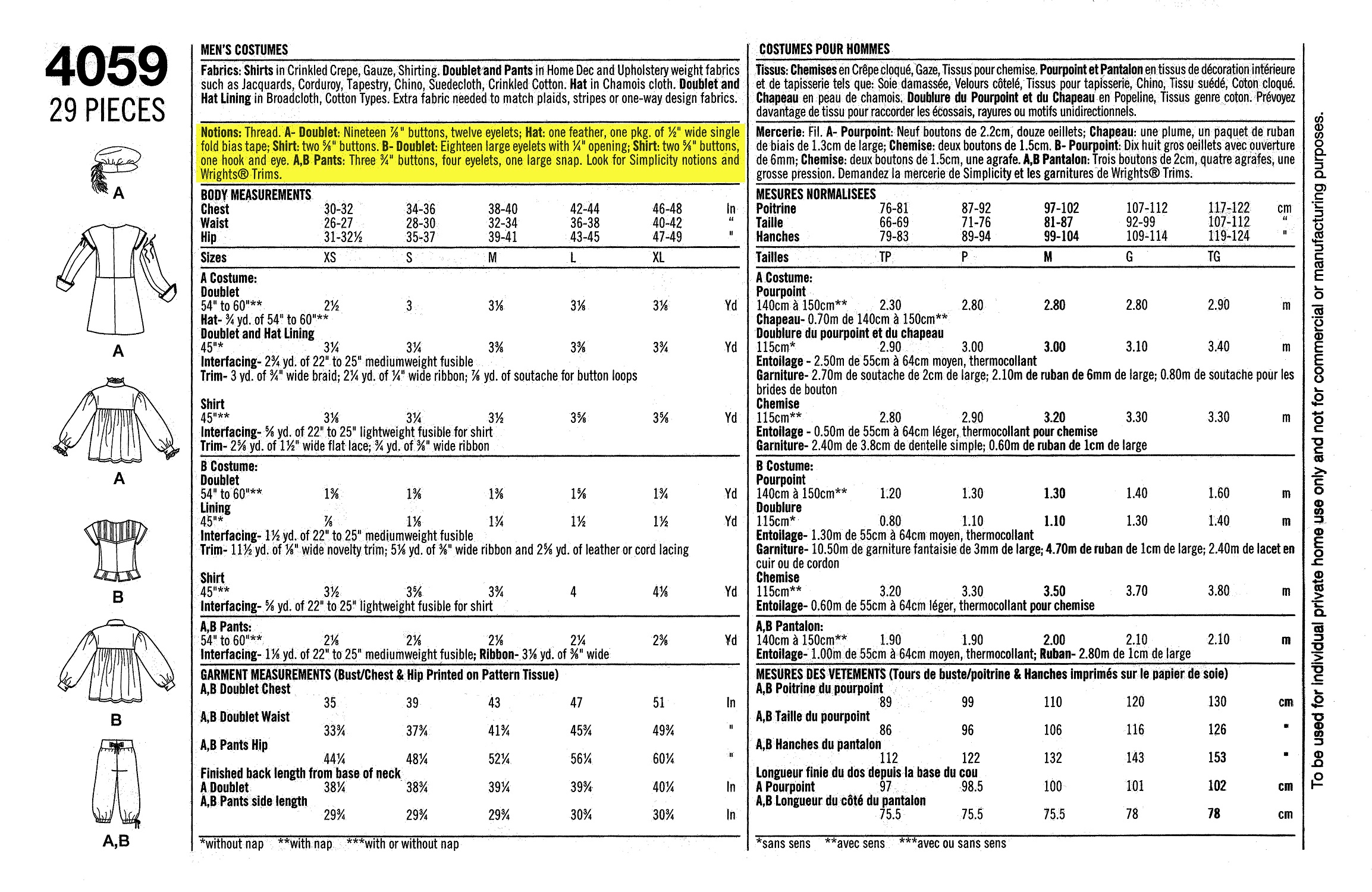
Notions are tools, supplies, and accessories used during the sewing and garment-creation process. These include things like pins, sewing needles, seam rippers, tweezers, and garment supplies such as thread, shoulder pads, bra cups, elastic, and zippers.
(I have no idea why they’re called “notions” instead of “supplies,” “accessories,” or something more seemingly relevant.)
Beneath the notions is a chart of body measurements to help you choose your size (which we covered above).
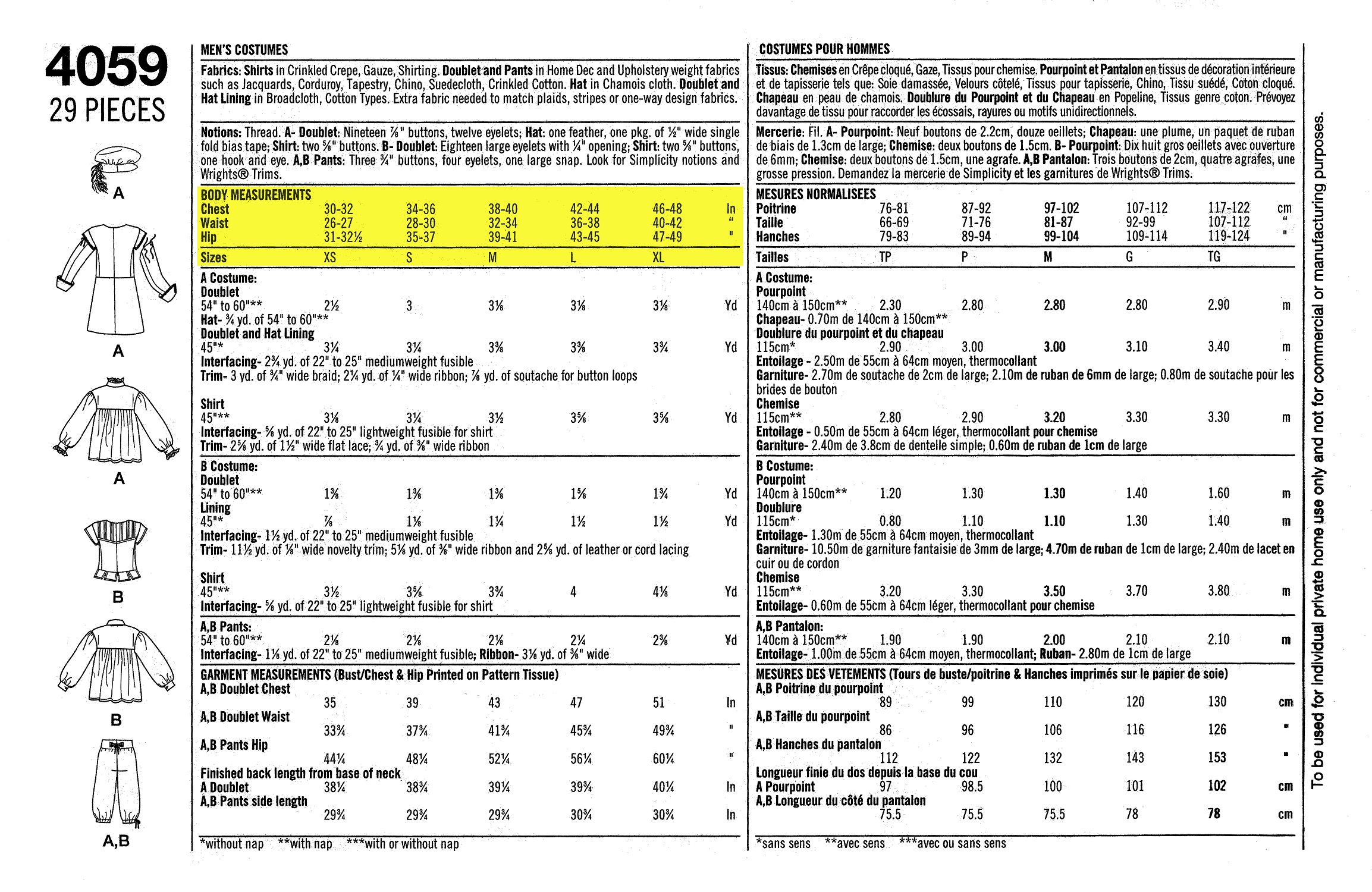
Here is some very important information: how much fabric you’ll need for each garment in each size.
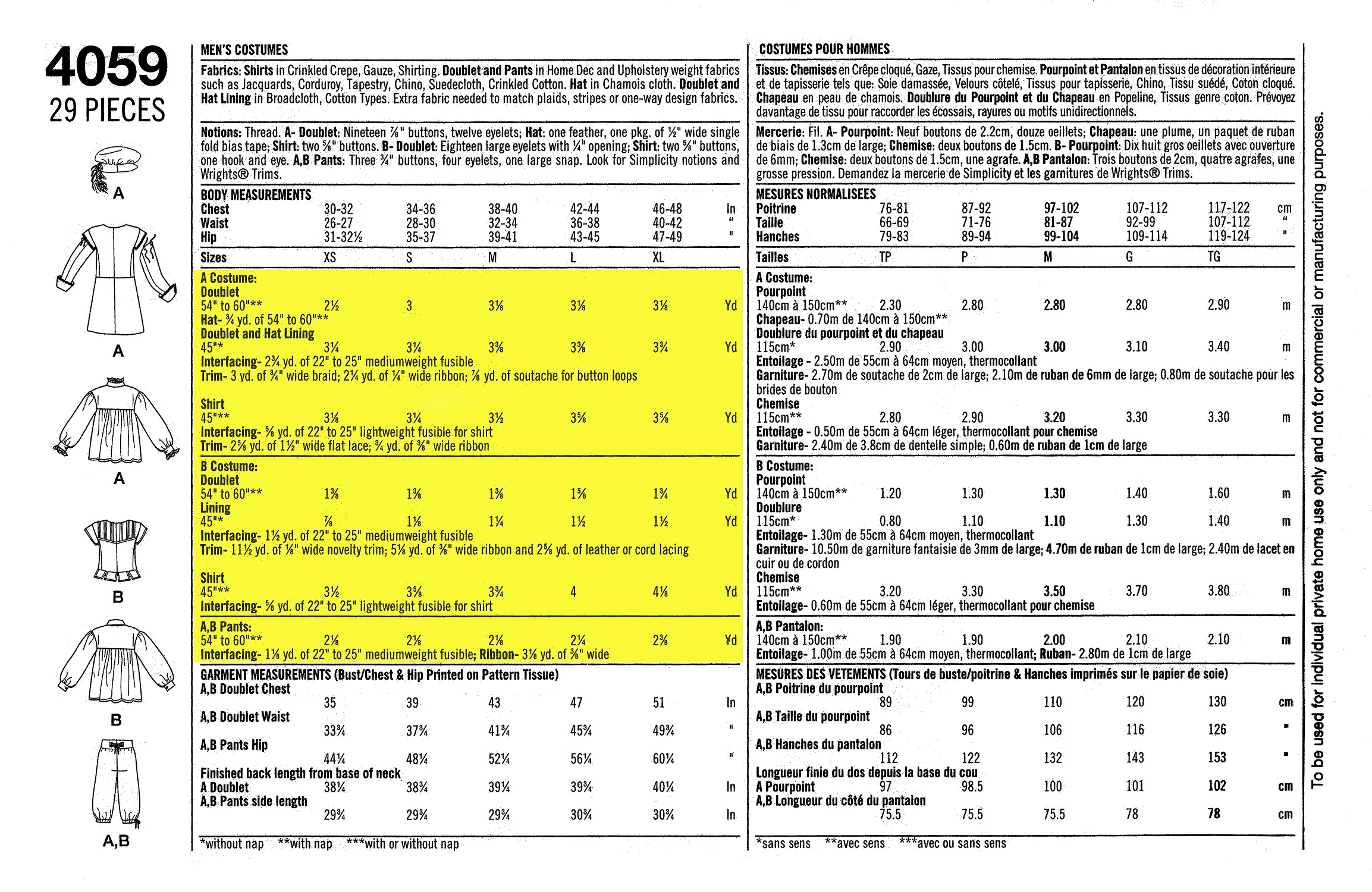
Voice of experience here – I usually prefer to get a little more than they suggest, “just in case.”
The fabric might shrink a little after being washed and dried, or you might mess something up and need to replace some pieces; you never know.
I’d always rather have a little more fabric than I think I’m going to need than risk not having enough, or not being able to replace anything I messed up.
Worst case scenario, I waste a few dollars, but I don’t see it as a waste; I see it as buying peace of mind.
You should also know that most fabrics generally come in two different widths: about 44-48” and 55-60”.
They’re often just rounded and referred to as 45” and 60” fabrics, though, and the amount of fabric you’ll need for a project depends on the width; generally speaking, you’ll need more of a 45” fabric than a 60” one.
Usually, the pattern will say you need [X] yards of 60” fabric, or [Y] yards of 45” fabric.
Sometimes they might be the same, though.
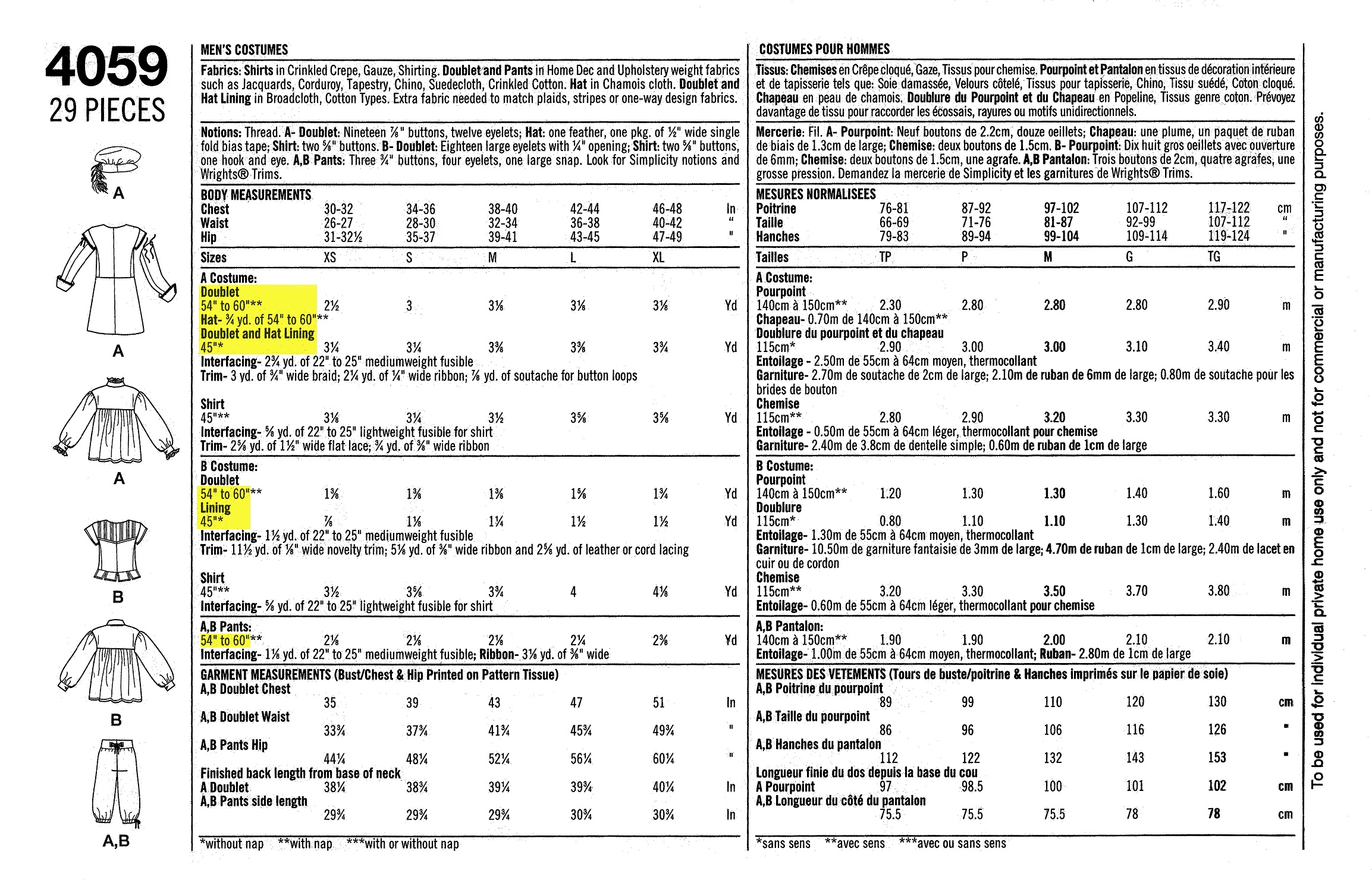
Depending on what you’re making, you might need more than one fabric.
You might need some of one color and some of another color; you might need some fabric, and some interfacing, and some lining.
The pattern should tell you everything you need, and how much of it.
Purchasing Fabric
If you order your fabric online, there’s typically a dropdown menu for you to select your quantity in yards/meters.
I prefer to buy my fabrics in-person whenever possible, so I can see and feel them to assess their potential use (or lack thereof) for my projects.
Sometimes fabrics come on rolls, and sometimes they come on cardboard rectangles called “bolts.”
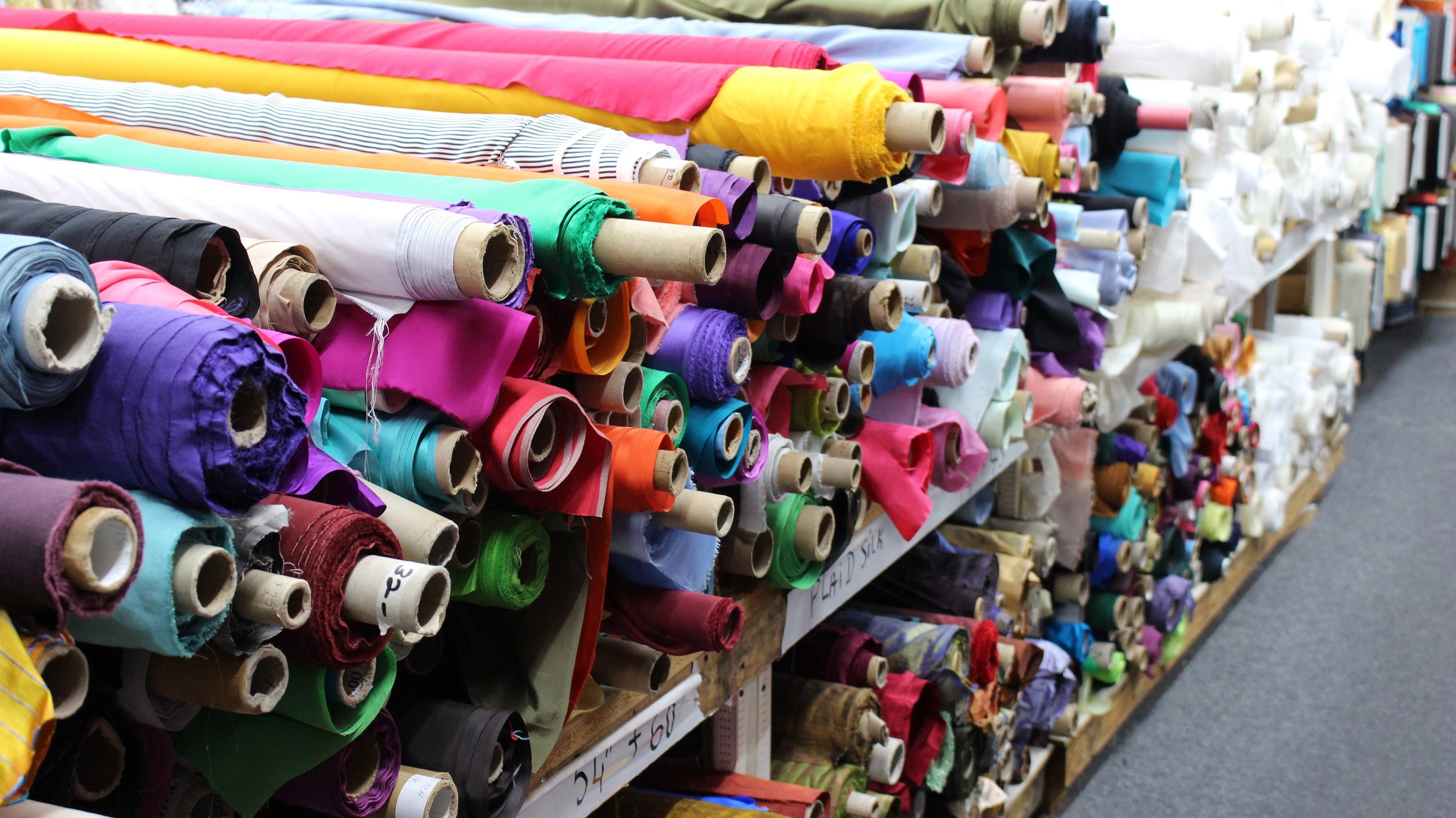
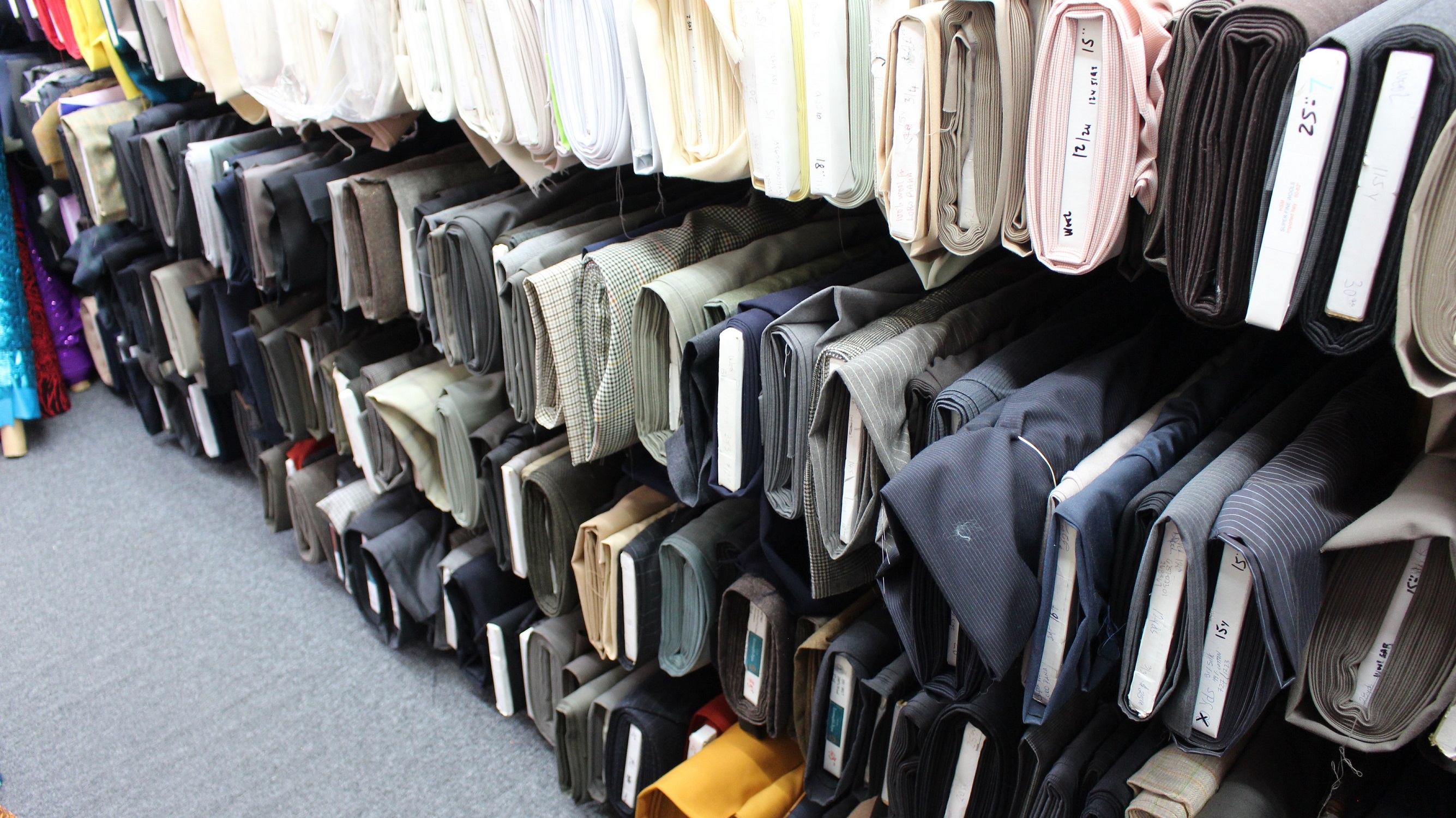
Once you’ve chosen your fabric(s), you typically bring your selection(s) to a cutting counter or table and tell the employee how much you’d like to purchase.
(It’s important to decide this beforehand since once the fabric’s cut you’re committed, and it’s also courteous to those in line behind you.)
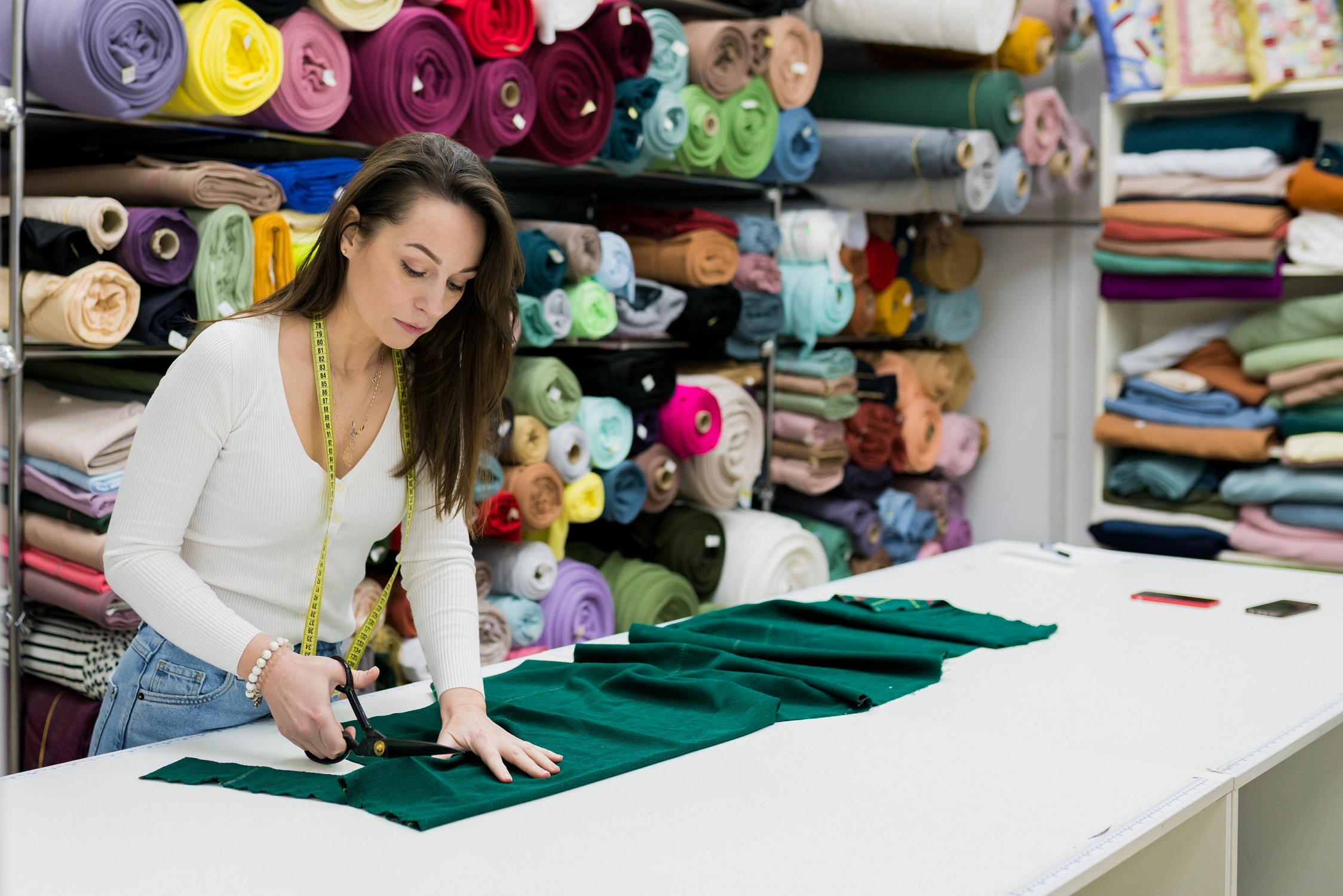
They’ll cut your fabric, fold it for you, and provide you with a small receipt or invoice to bring to the checkout.
Wearing Ease
Not all patterns have this on the envelope (or at all), but at the bottom, they may provide you with some of the finished garment measurements.
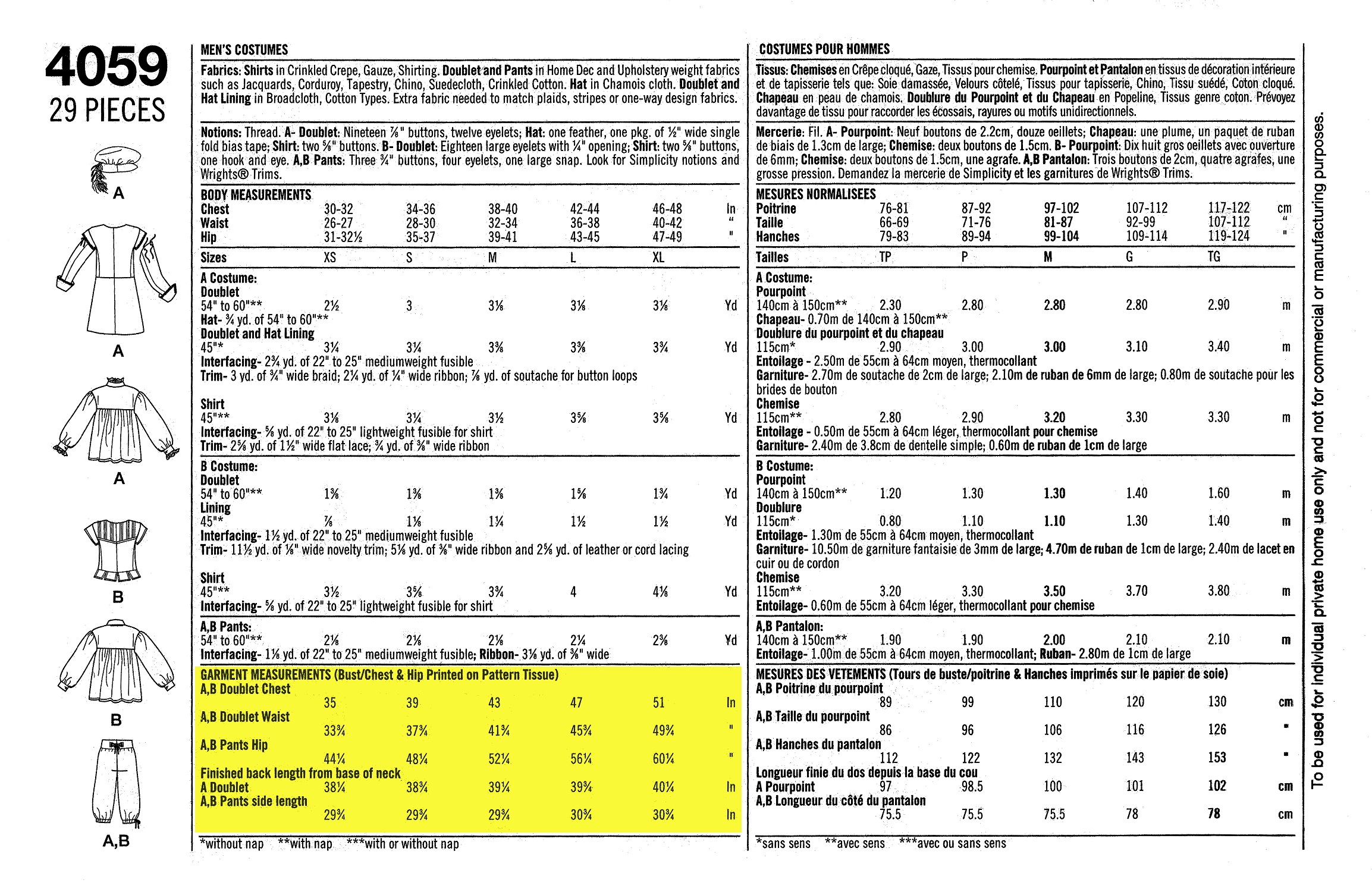
It’s always nice when they tell you this, especially on the outer envelope (sometimes it’s on the instructions inside, or printed on a piece of the pattern itself), because you can use it to help choose your size.
This is what I was referring to earlier.
Notice that the “body measurements” above and the “garment measurements” below aren’t the same; that’s because, unless it’s supposed to be a skin-tight garment, there’s been some wearing ease added.
Obviously, different garments are supposed to fit in different ways; some are supposed to be baggy, while others are intended to be snug. The specific amount of wearing ease varies accordingly.

Generally speaking, for a well-fitting jacket, you’ll probably want about 3” of ease around the chest for the ladies, and about 4” of ease for the men – maybe a little less, maybe a little more.
For a waistcoat, a mere inch or so usually works for smaller ladies’ sizes, and 2” is typically a good fit for larger ladies’ sizes, and men’s sizes. (Maybe a little more around the waist, too, since it can be cinched snugly with the back straps.)
For pants, usually about an inch of ease around the waist is a comfortable fit for ladies, while 1 ½” might be more common for men.
But for some reason, a lot of patterns include way more wearing ease than this.
I don’t know why – vanity sizing, perhaps? – but it can be annoying to deal with, so I usually like to choose my size using the finished garment measurements: my body measurement, plus however much wearing ease I want there to be.
Inside the Envelope
When you open the envelope, inside you should find two things: the pattern itself (usually beige or tan tissue paper) and the instructions (which unfold like a map).
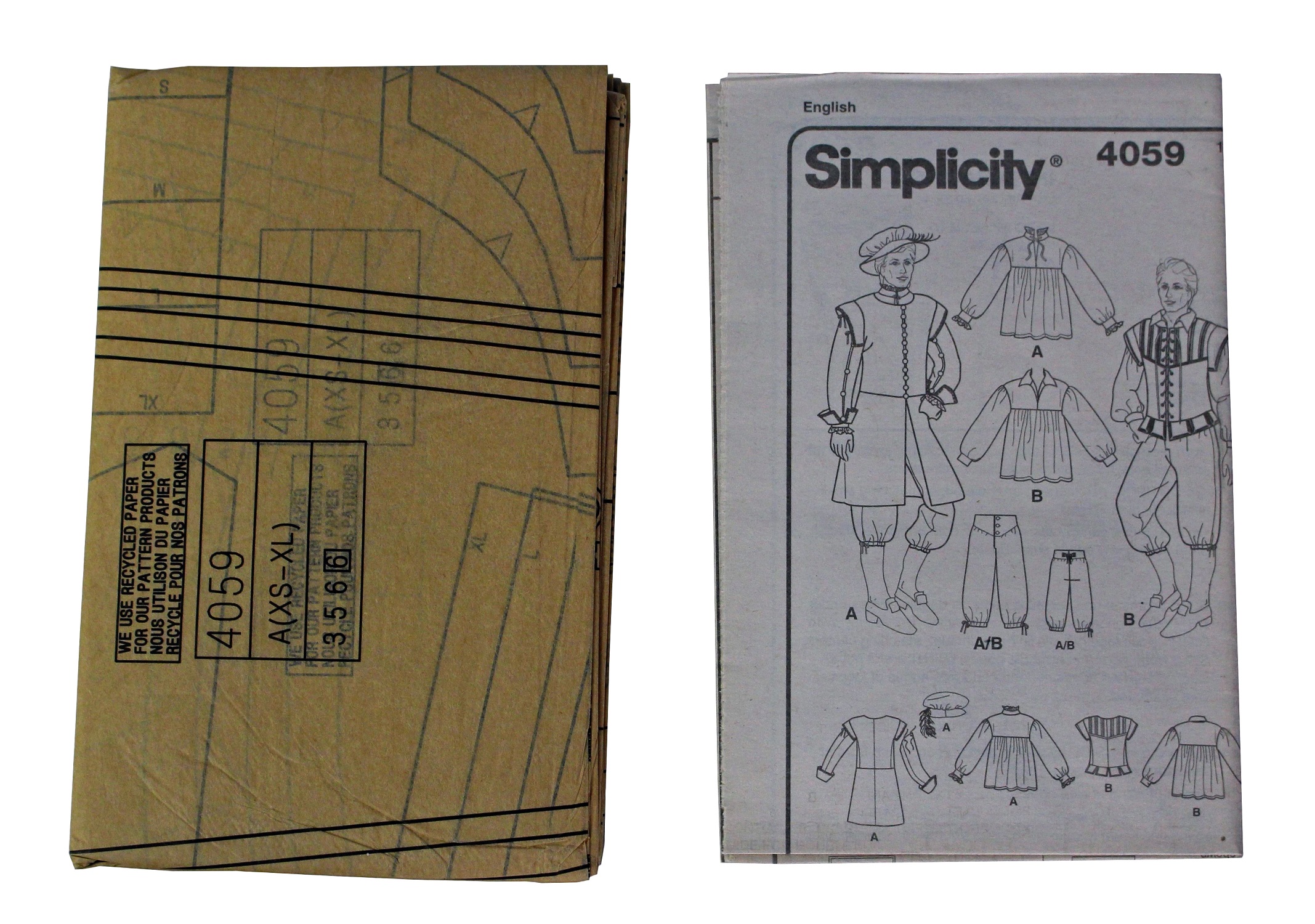
Like the back of the pattern envelope, the instructions should provide you with important information.
On the upper left, they usually list the pattern pieces for you and tell you which ones you need for each garment or style, since you might not need them all.
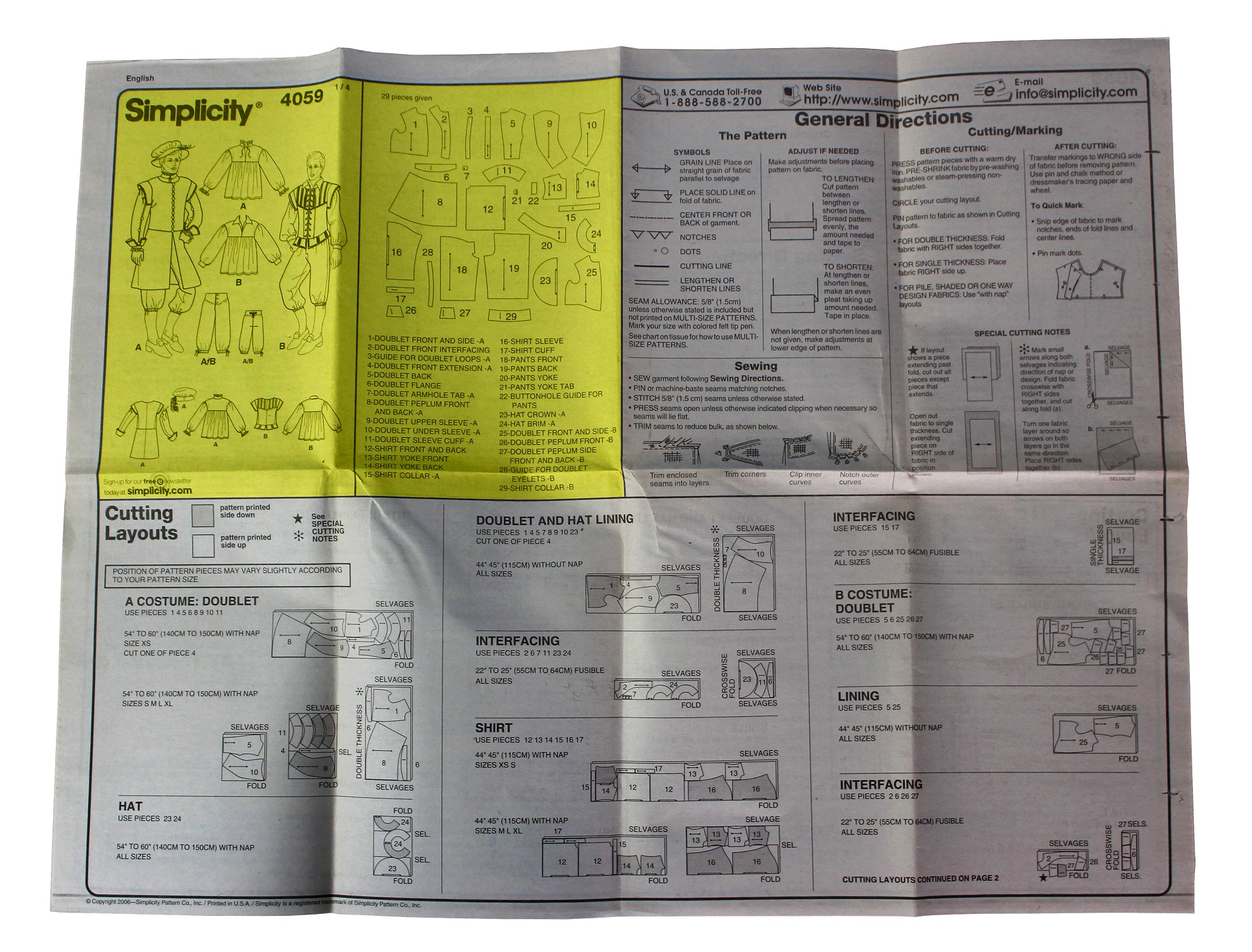
On the upper right is usually an explanation of symbols you might see on the pattern, and we’ll talk more about those shortly.
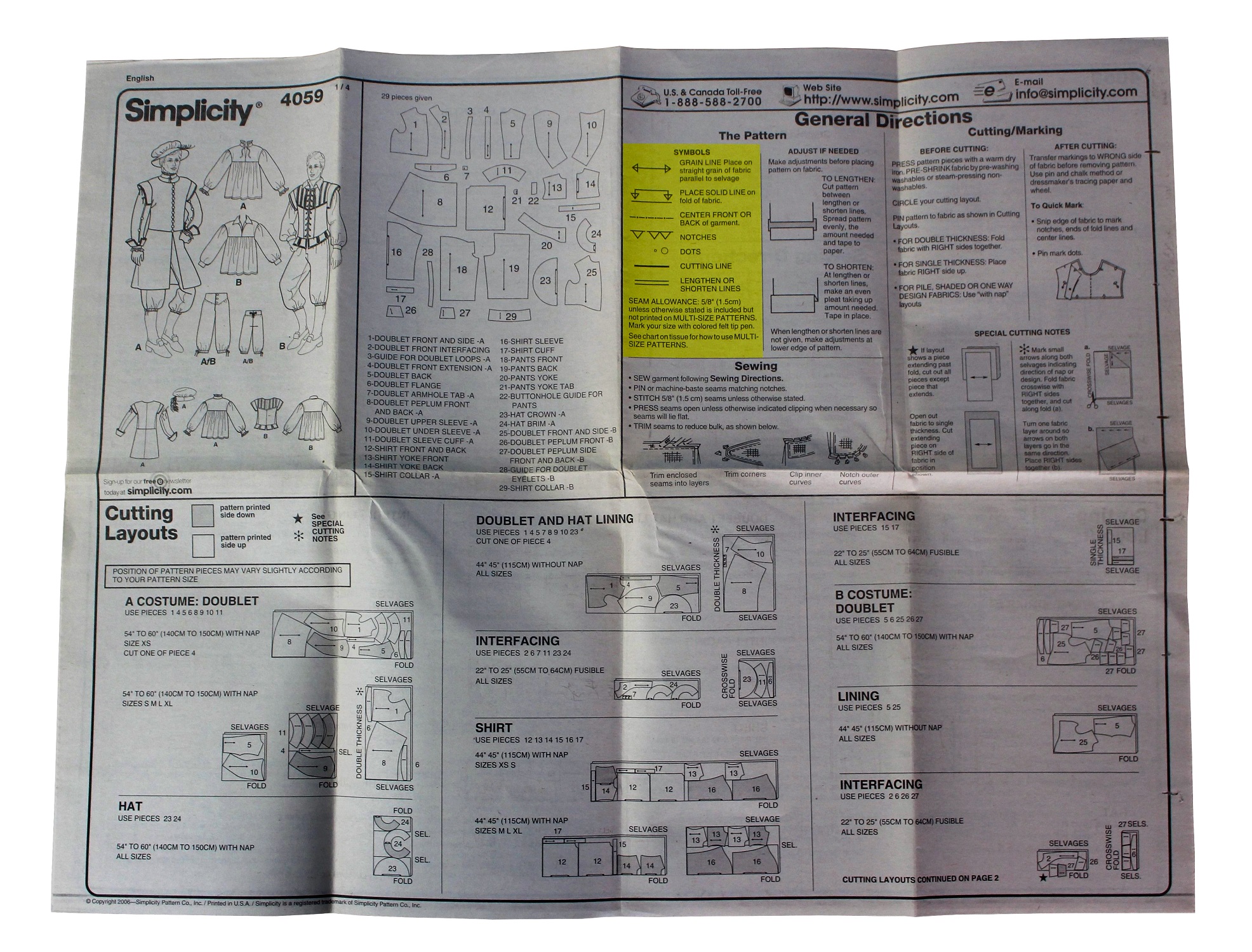
Next to the symbols are more general tips and directions.
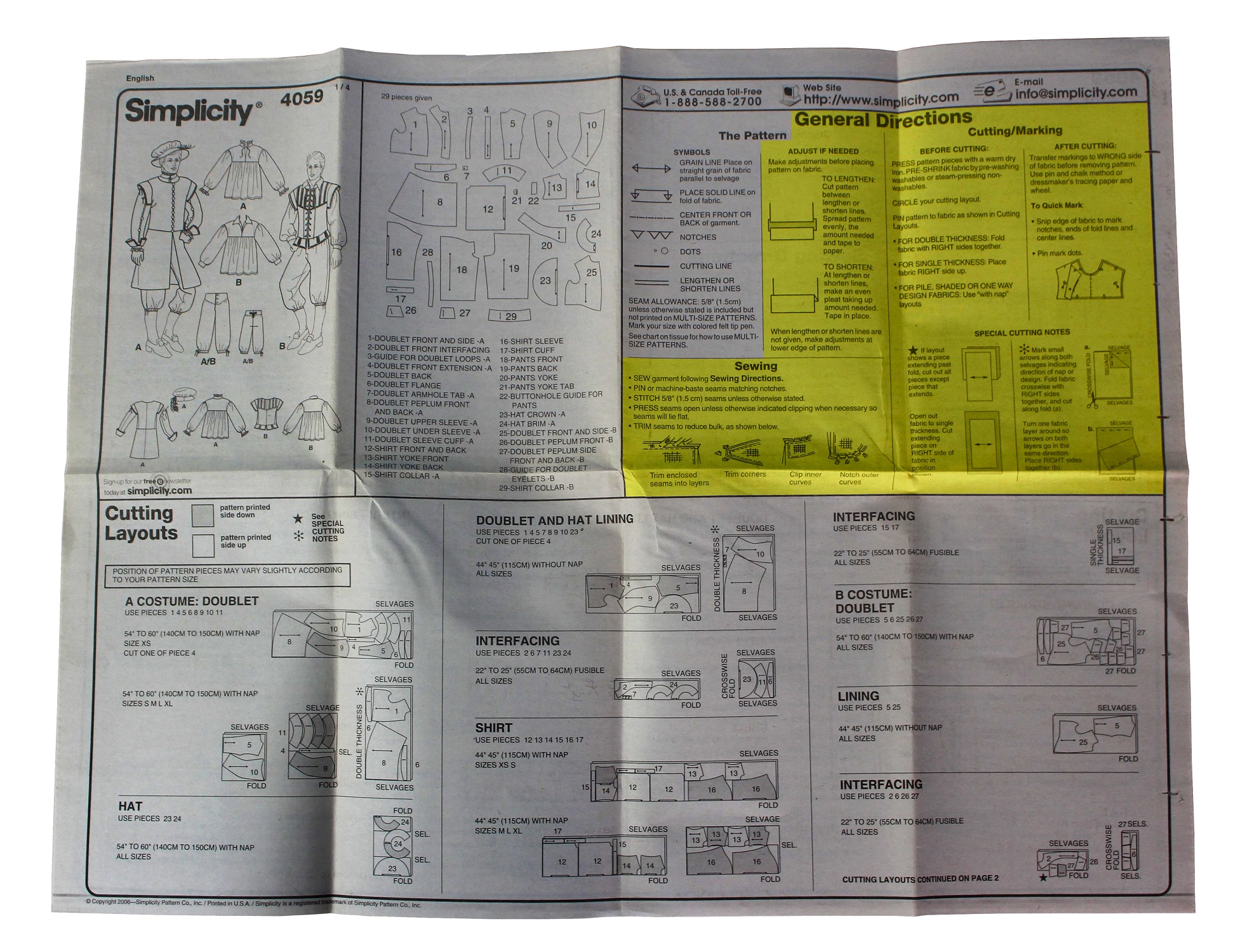
Below that are some recommended fabric cutting layouts.
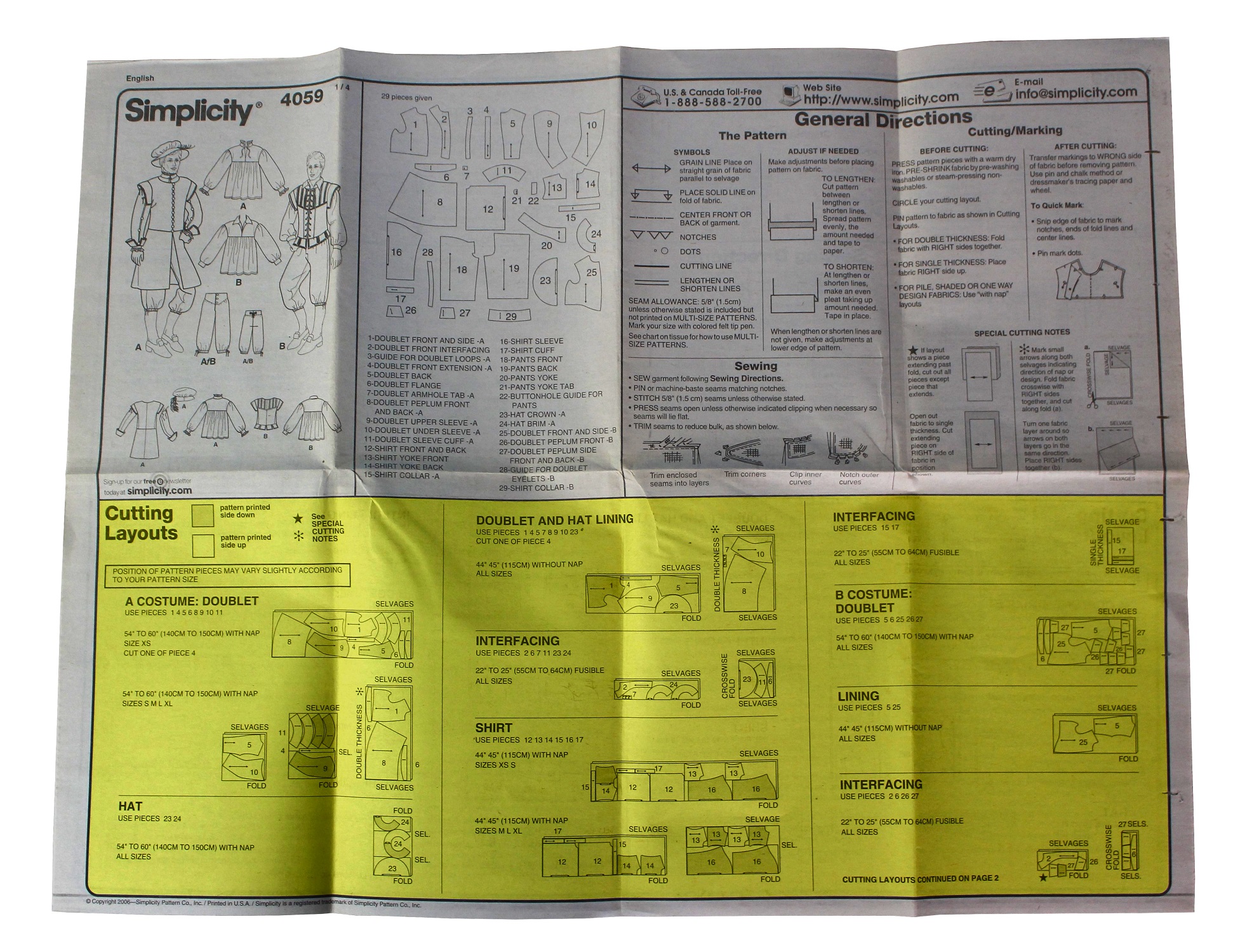
Again, it’s up to you if you want to use them or not, but if you’re a beginner, you probably should.
I never even look at them anymore, because I usually just play Tetris with the pieces myself to get the most mileage out of my fabric.
And then the actual sewing directions start!
Before Starting
Before cutting your fabric, you’ll want to pre-shrink it.
You don’t want the fabric to shrink during the construction process, or for everything to shrink after you’ve finished making the garment.
With retail fabrics, care instructions are usually found on the end of the bolt.
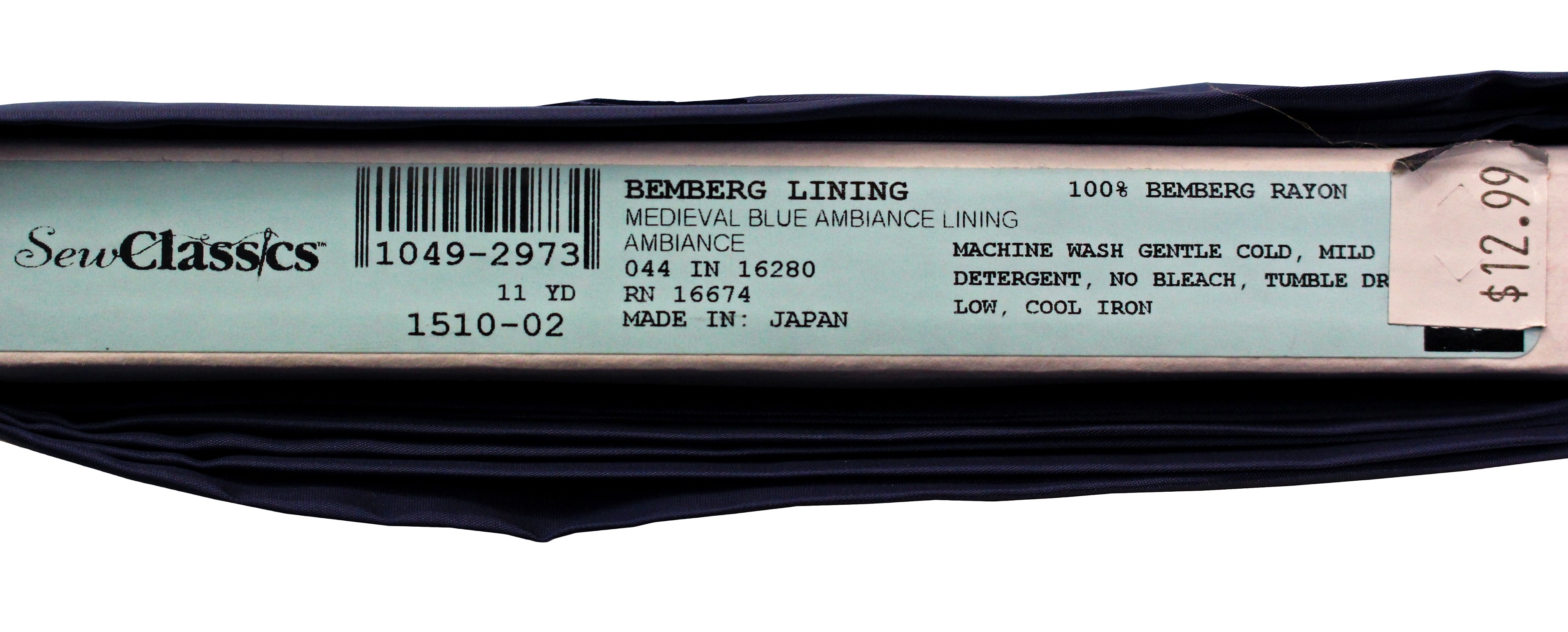
Most of the time, retail apparel fabrics are machine-washable and dryable – but not always.
If they are, wash and dry your fabric at whatever temperature they recommend, then iron it nice and flat.
If not, some need to be soaked, or line-dried, or even just used as they are.
Using the Pattern
Unless you have a large table you can use, you’ll need to spread your fabric across the floor, nice and flat, with no wrinkles.
Hardwood floors, wood laminate, or even tile are ideal for this – basically anything but carpet.
(Personally, I hate cutting on carpet … but obviously work with whatever you have available.)
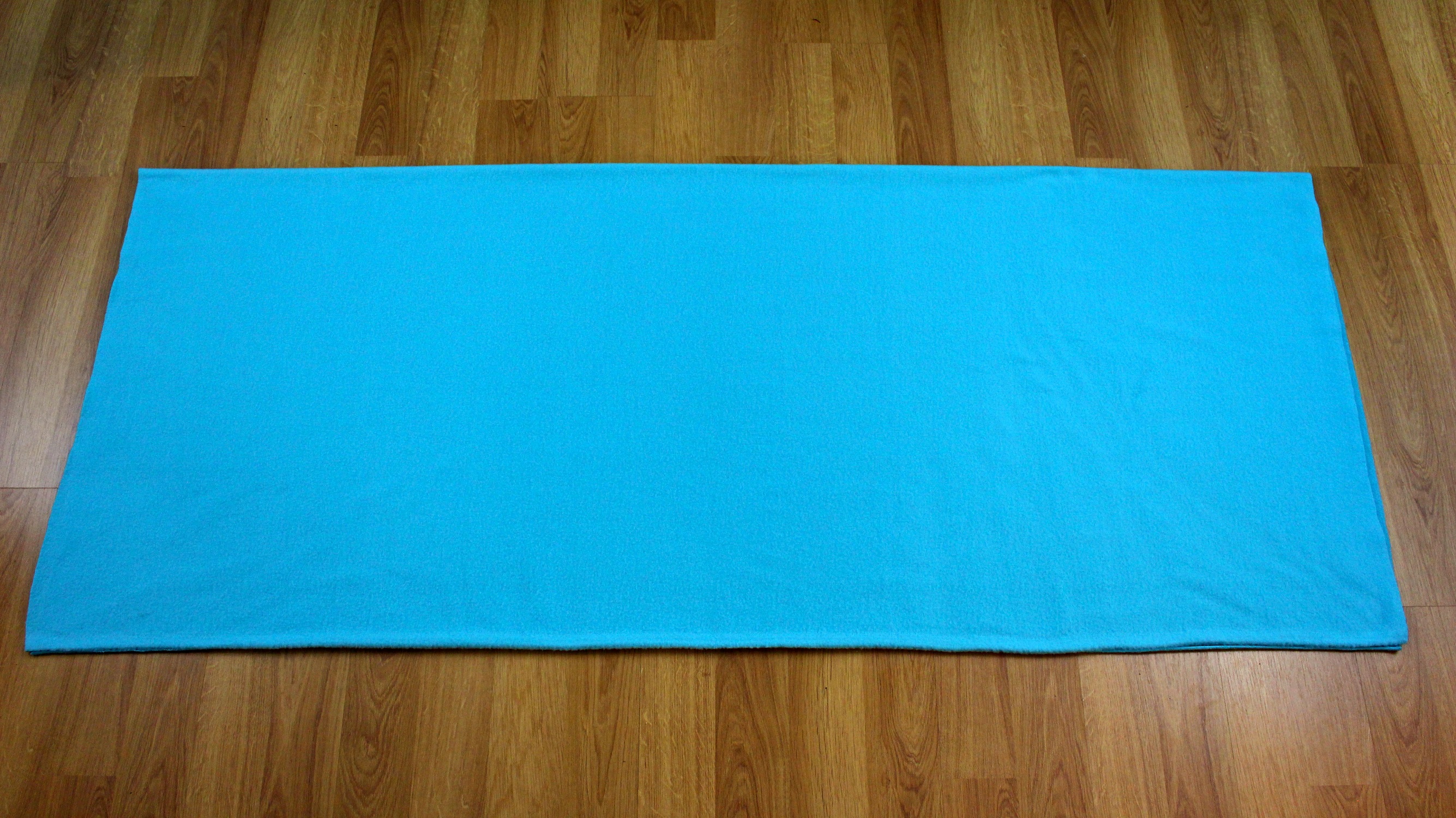
Usually the pattern-maker will assume you’re folding the fabric in half so the outer edges are flush.
The outer, uncut edges of the fabric are called selvages (also sometimes spelled “selvedge”).
It’s up to you if you want to do it this way or not; I usually prefer to cut single layers of fabric, but both ways have their pros and cons.
Cutting two layers at once is obviously faster, but with only one layer, you have more direct control over exactly where you’re cutting … so it just depends on what your priority is.
Some pieces may say, “Cut on fold,” or, “Place on fold,” and you can do it that way if you want. (See right.)
Alternatively you can establish your center, do one side, flip the pattern piece over, and do the other side.
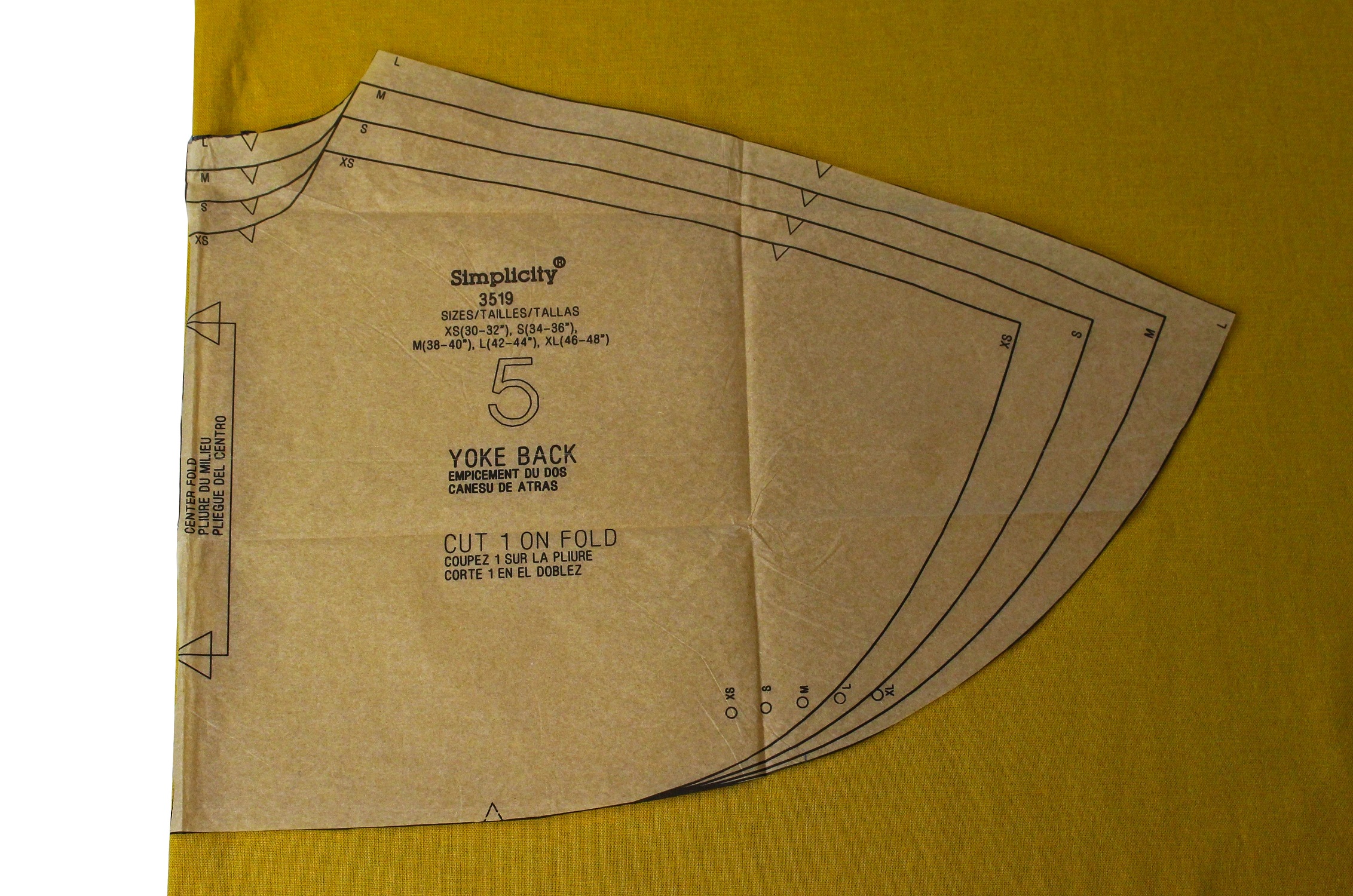
Pattern pieces often have a long arrow on them, which usually indicates the direction of the lengthwise grain.
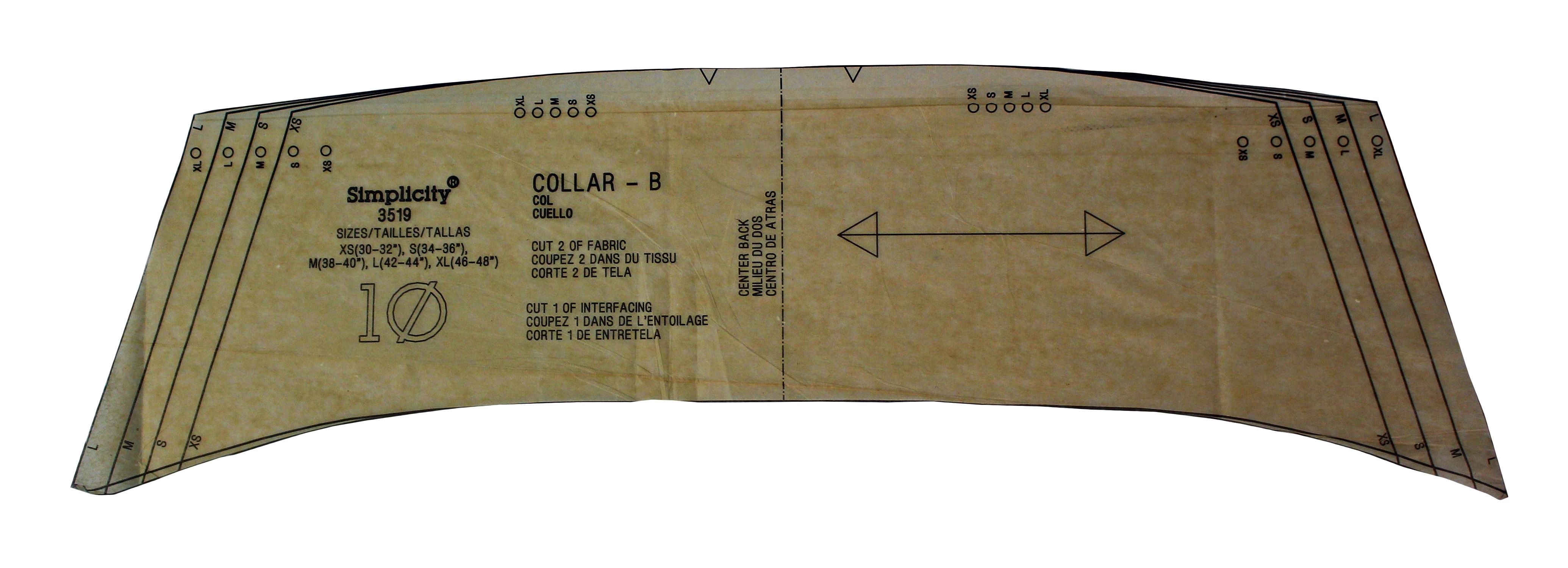
When looking at the fabric from above, the vertical direction (parallel to the selvages) is called the lengthwise grain, the straight grain, or just “the grain” for short.
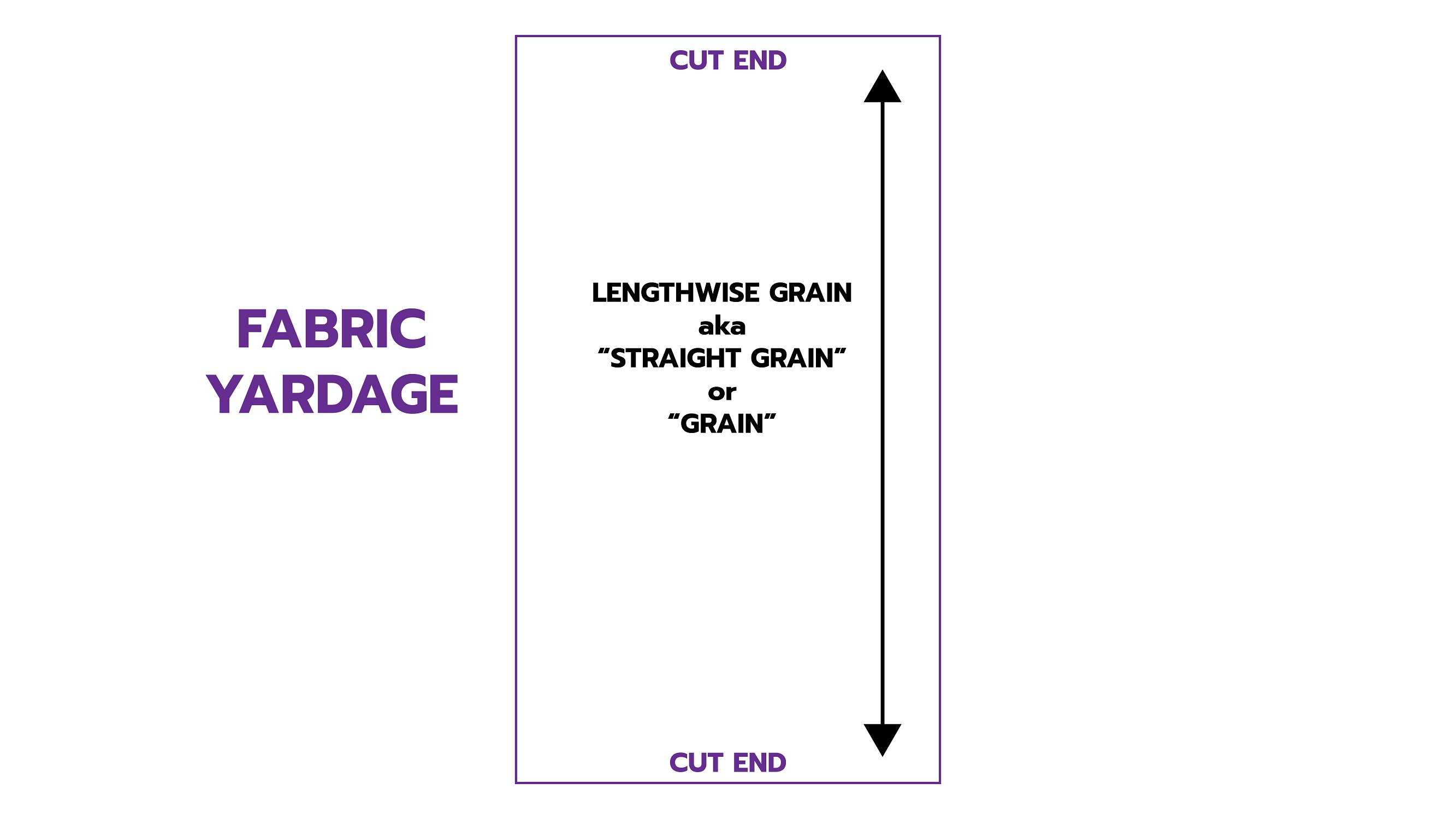
The horizontal direction, from selvage to selvage, is called the crossgrain.
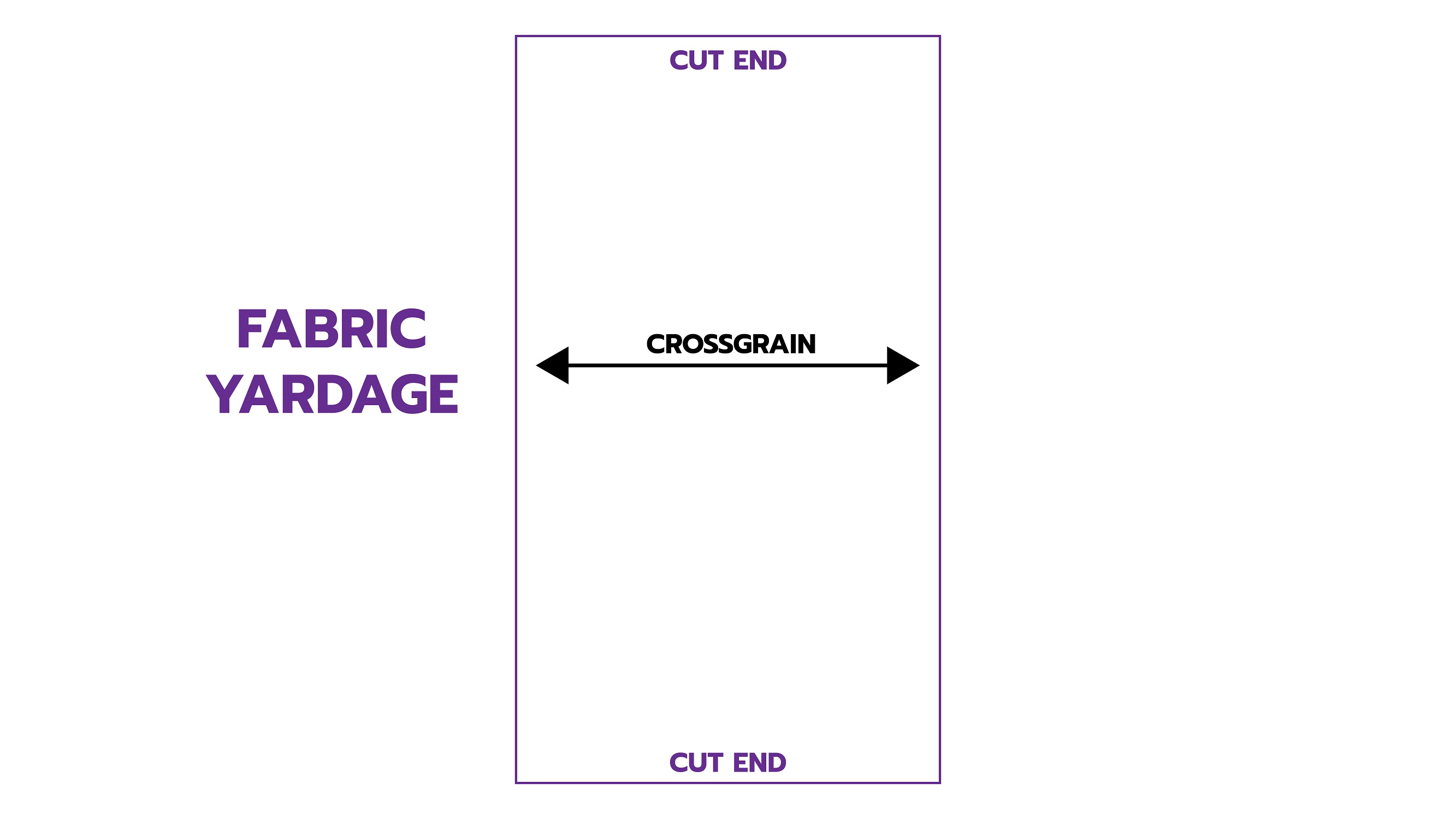
The fabric’s diagonal is called the bias.
If it’s at a 45° angle to the grain, it’s called the true bias.
Whenever someone refers to the “bias,” it’s usually to the true bias.

So use these for reference, with the arrow on the pattern piece, to help you orient it properly before cutting.
Cutting Your Fabric
There are several different methods for cutting our fabric with your sewing patterns. I’ll describe them for you, so you can choose which one(s) you like.
Many people like to cut around the pattern pieces on the tissue paper, then pin the paper to the fabric to hold it in place and cut through both or all layers along the appropriate line.
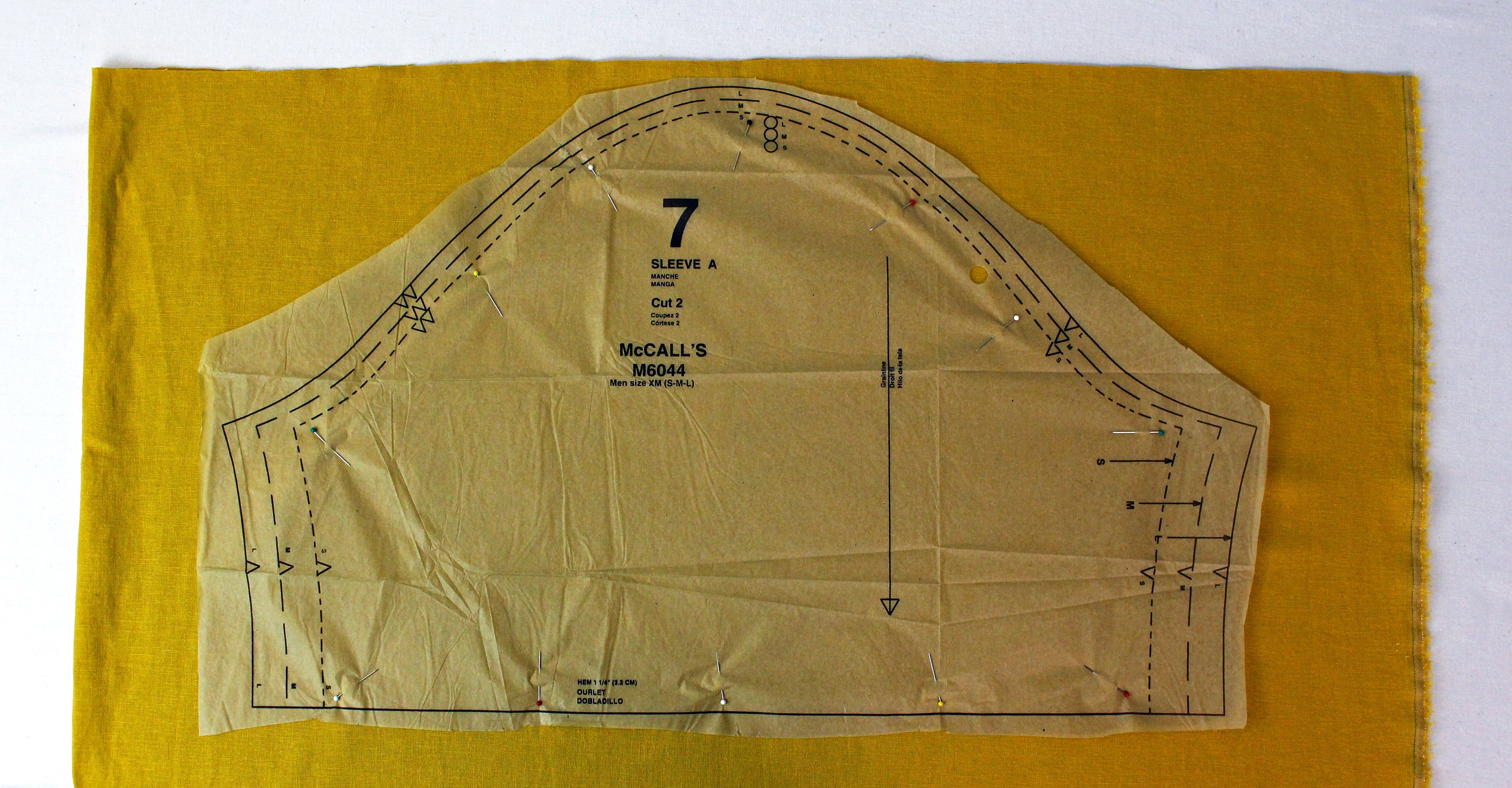
This way is fine, but it’s actually my least favorite method; I don’t like to cut through paper with my fabric scissors if I can help it, and I prefer to see exactly where I’m cutting on the fabric.
All the pinning is not only time-consuming, but it also punches lots of little holes in the tissue paper, which is already pretty brittle and delicate.
You can use pattern weights instead, which will save you some time and wear-and-tear on your pattern … but there are still the other issues I mentioned.
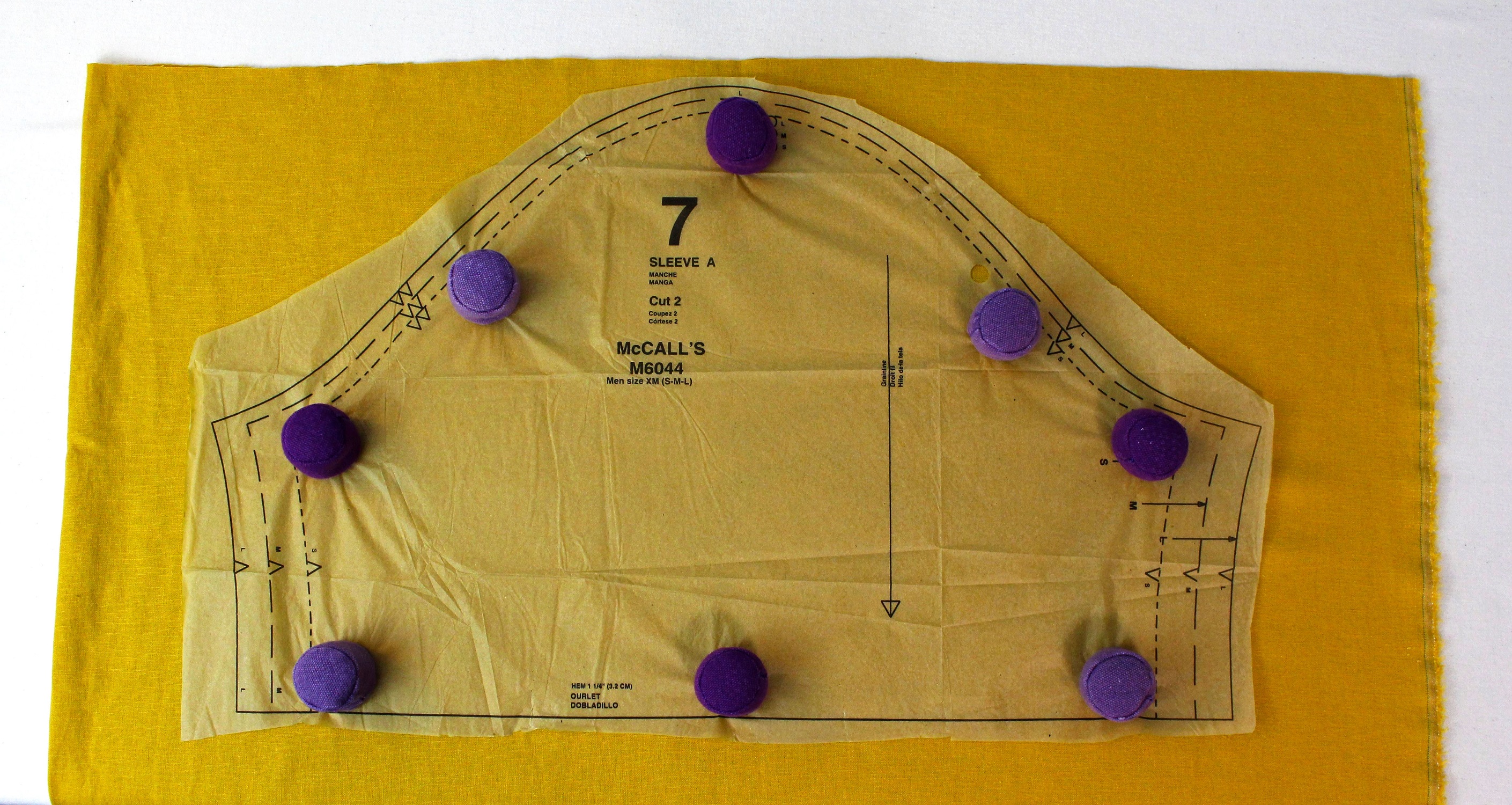
Another technique is to cut the paper pattern out first with regular paper scissors, then position it onto the fabric with pins or weights and cut around it.
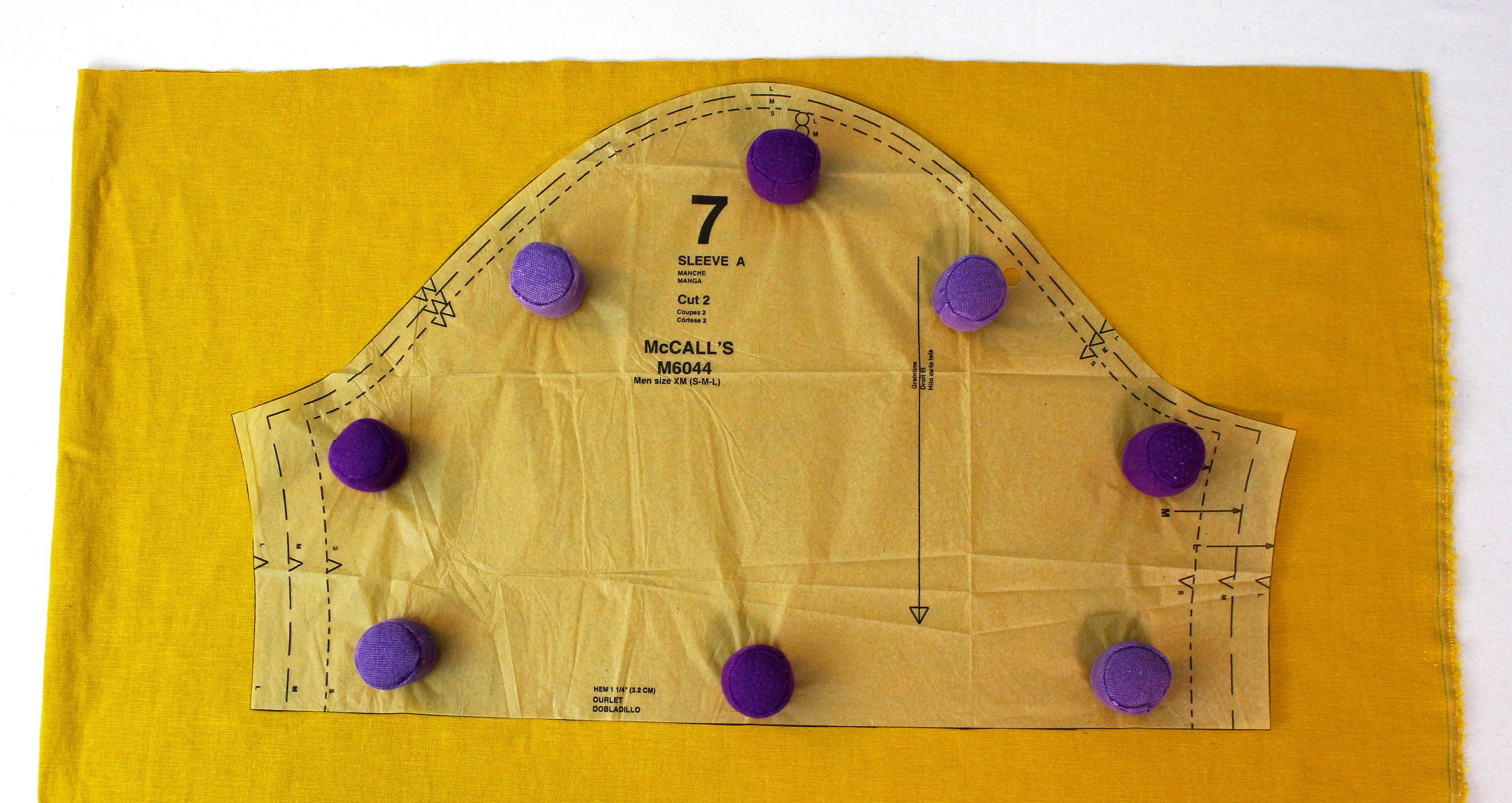
I like this way a lot better, because I’m not cutting the paper with my fabric scissors, and I can better see where on the fabric I’m cutting.
Some people like to use a rotary cutter with a cutting mat.
Those are pretty cool, and they’re nice and fast; they make a quick, clean cut.
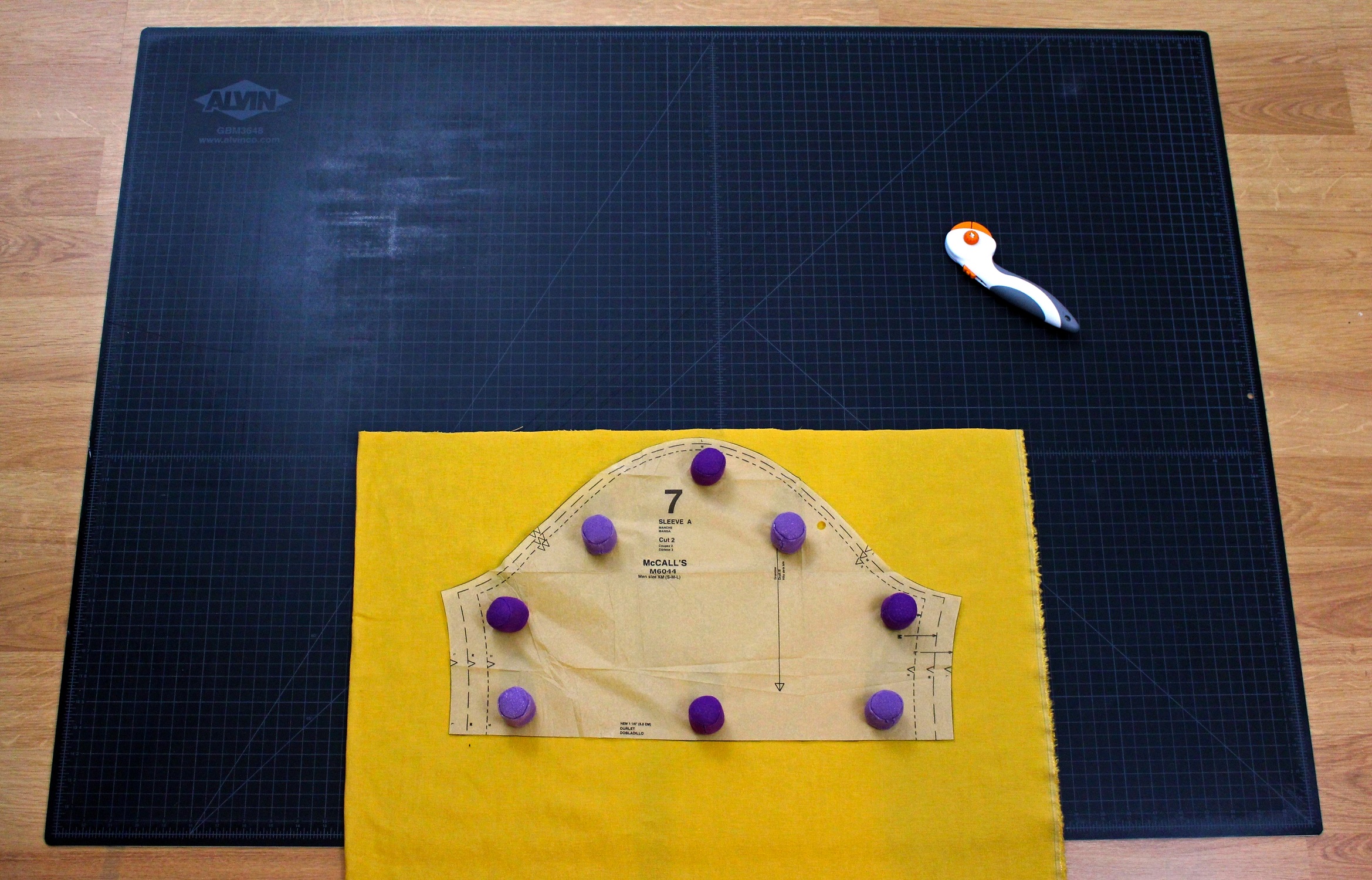
We’ll discuss these more in our Advanced Sewing course; they’re really handy for a few things, but I don’t like to use them for larger cuts of fabric because they’re usually not very big – not unless you have a table-sized one, or several large ones joined end-to-end.
The one pictured above is one of the largest ones you can buy, and even it’s only 36” x 48” – nowhere near big enough to cut pattern pieces out of several yards of fabric.
Personally, my favorite way is to cut the paper pattern out beforehand, position onto the fabric with pattern weights, and actually trace around the pattern with tailor’s chalk or a marker, then pull away the paper pattern so I can see exactly where the cutting lines are on the fabric.
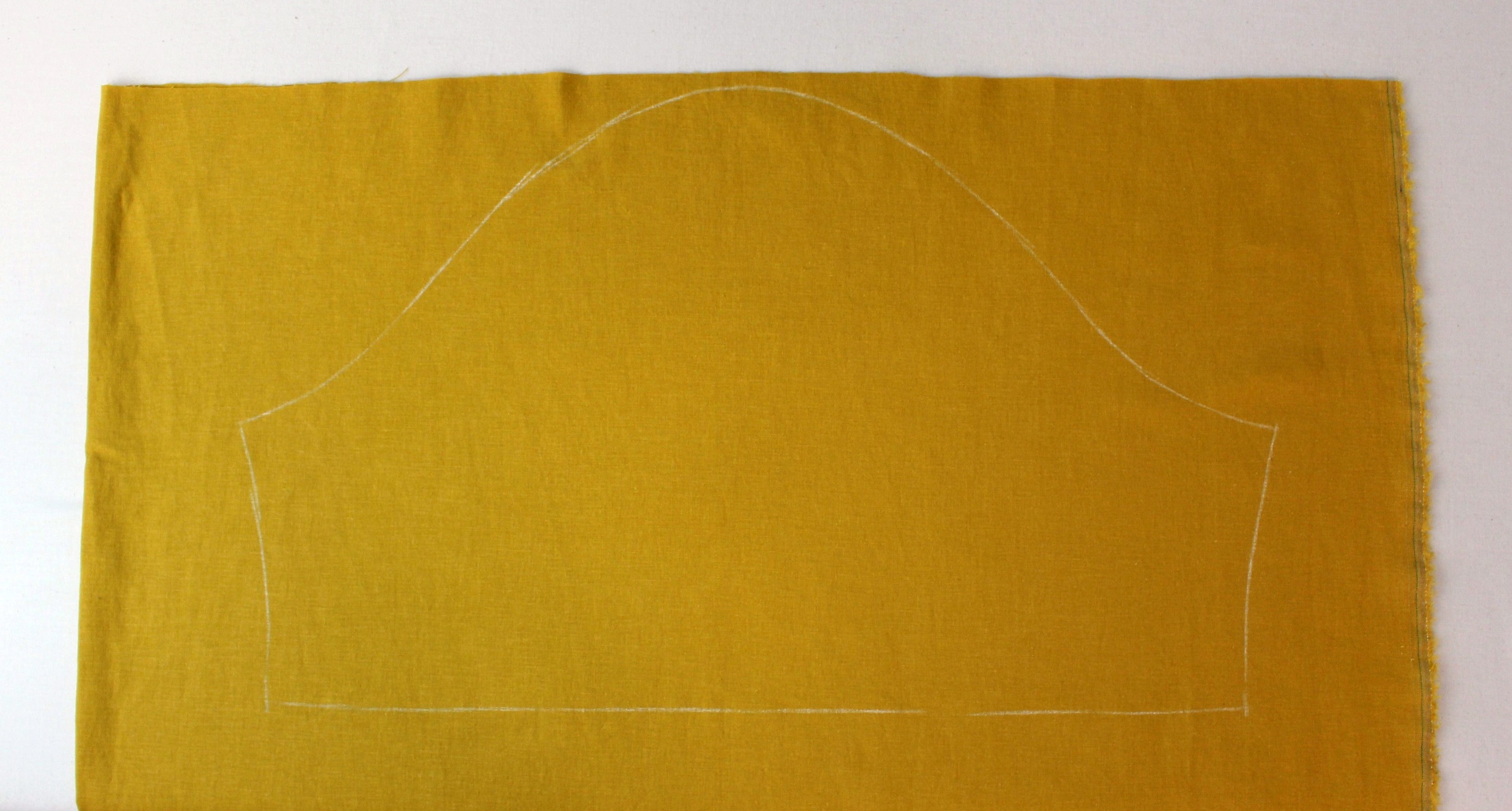
Precisely-positioned cutting lines aren’t very important with solid-color fabrics, but they’re crucial to get right when cutting stripes and plaids.
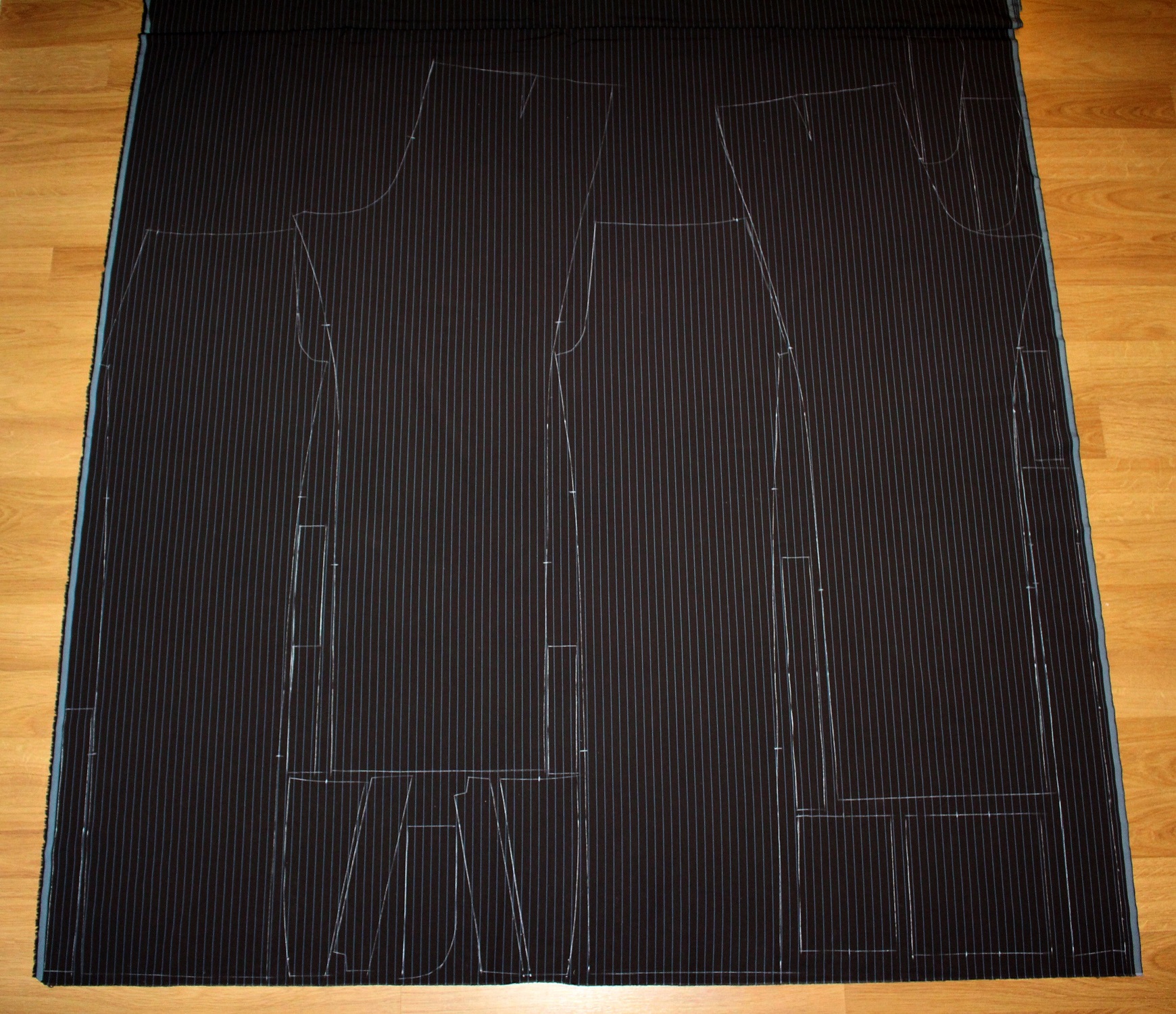
Pattern Markings
In addition to the edges of the pattern pieces, there are often some other pattern markings that you’ll want to be aware of.
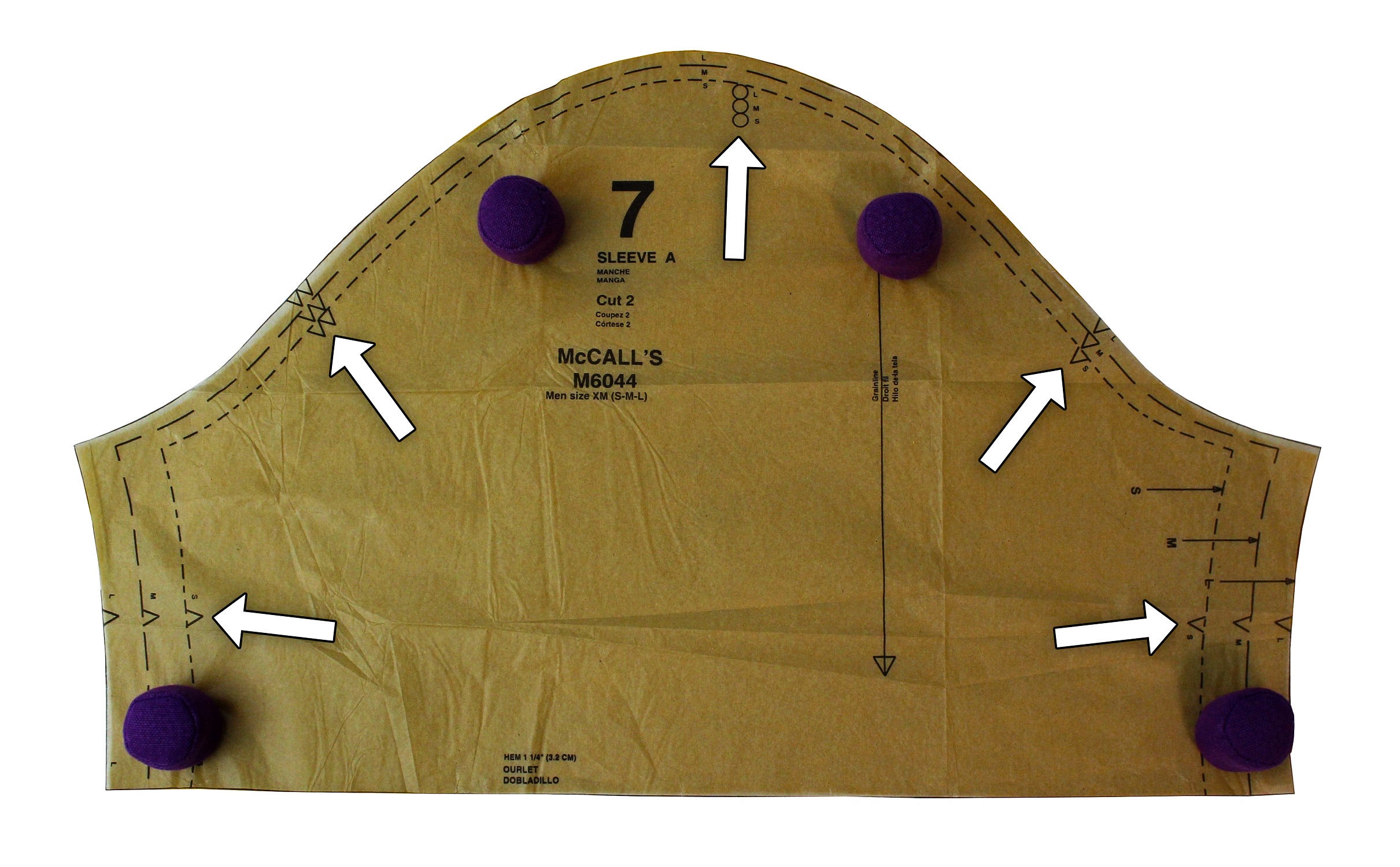
You may see marks for darts, pockets, pleats, buttons, balance points – all kinds of things.
And there are different ways you can mark them.
Assuming it’s something on the outer edges of the pattern piece, you can do what’s called “snip mark” – just make a tiny little cut in the fabric to mark whatever it is.
You could also just put a little pin in it where the mark is.
You can also literally mark it on the fabric with disappearing tailor’s chalk or a disappearing ink fabric marker. (I highly recommend testing these on a scrap first, though, to make sure they actually disappear.)
They all have their pros and cons; the little snip mark can be hard to see, especially if the fabric starts to unravel.
A pin can fall out, or you can accidentally pull it out when you think you’re doing something else.
You can accidentally steam out the chalk mark while you’re working on it, or the pen mark could fade before you get around to it.
So it’s up to you!
There are often small triangles and wedges sticking out, to indicate where pieces are supposed to properly align to each other.
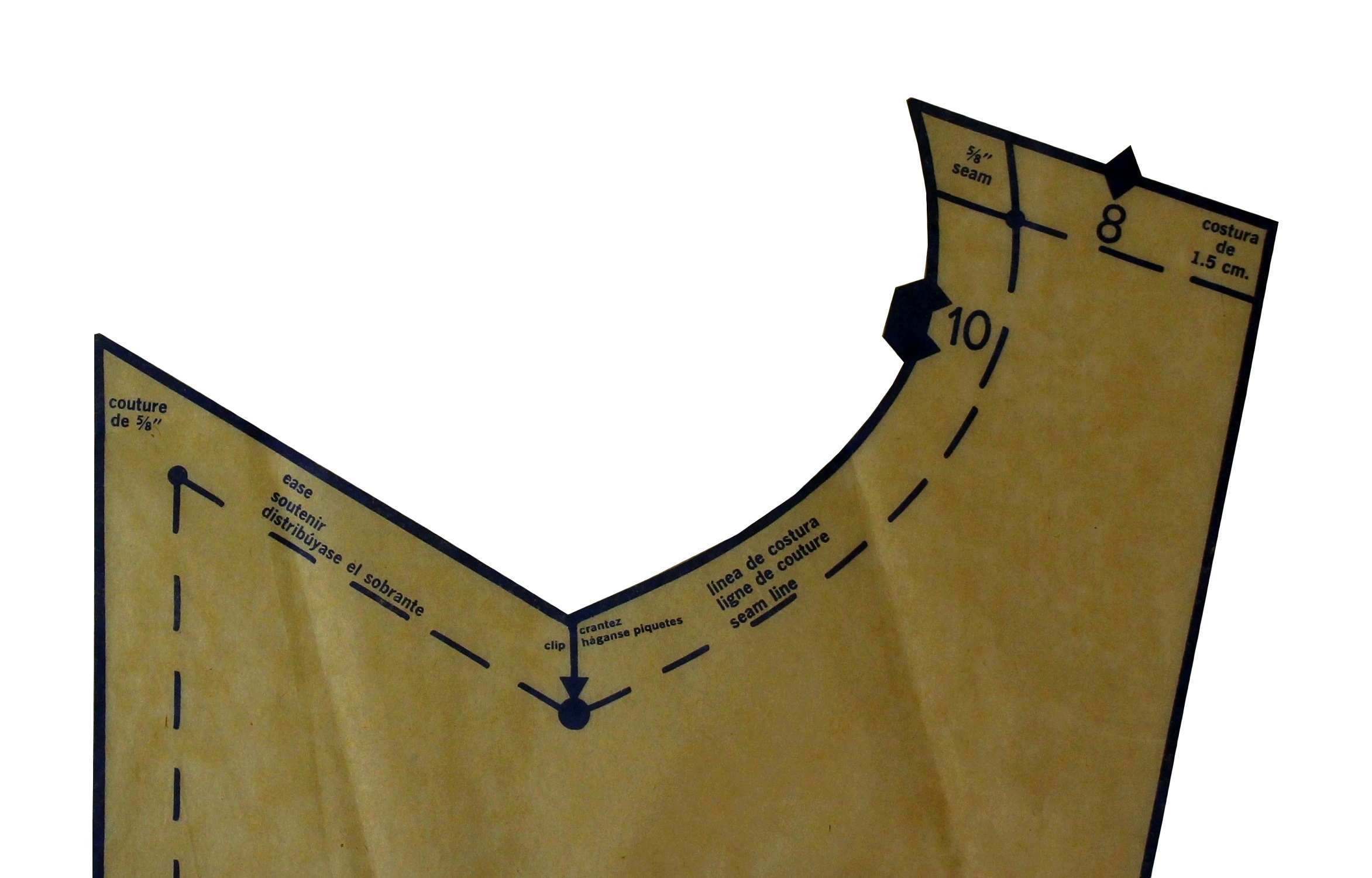
You can cut these little shapes into your fabric if you want, but I never do.
I cut straight over them and just mark their positioning on the fabric, usually with the aforementioned tailor’s chalk – one dash for general marks and the front, two marks for the back.
Beginner Sewing Course
If you found this helpful, you may be interested in our Beginner Sewing course.
With nearly 3 hours of sewing instruction over 20 lessons, this course is packed with everything you need to know to get started sewing.
No prior sewing knowledge or experience is necessary; you can learn at your own pace, and you can take the sewing lessons as many times as you want.
Experience for yourself how enjoyable sewing can be, and how fast you can learn!
This course includes:
- 20 Video Lessons (in Full HD)
- Nearly 3 hours of magical sewing instruction
- Book-length PDF download with hundreds of photos and diagrams
- Instant, lifetime access
- 100% money-back guarantee
Subscribe to our SEWING WIZARD NEWSLETTER for FREE sewing lessons, announcements, special offers, and more!
Thousands of
happy costumers!
It's been a privilege to have helped so many sewing wizards along their journey.
Here's what people are saying about our sewing patterns!
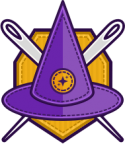

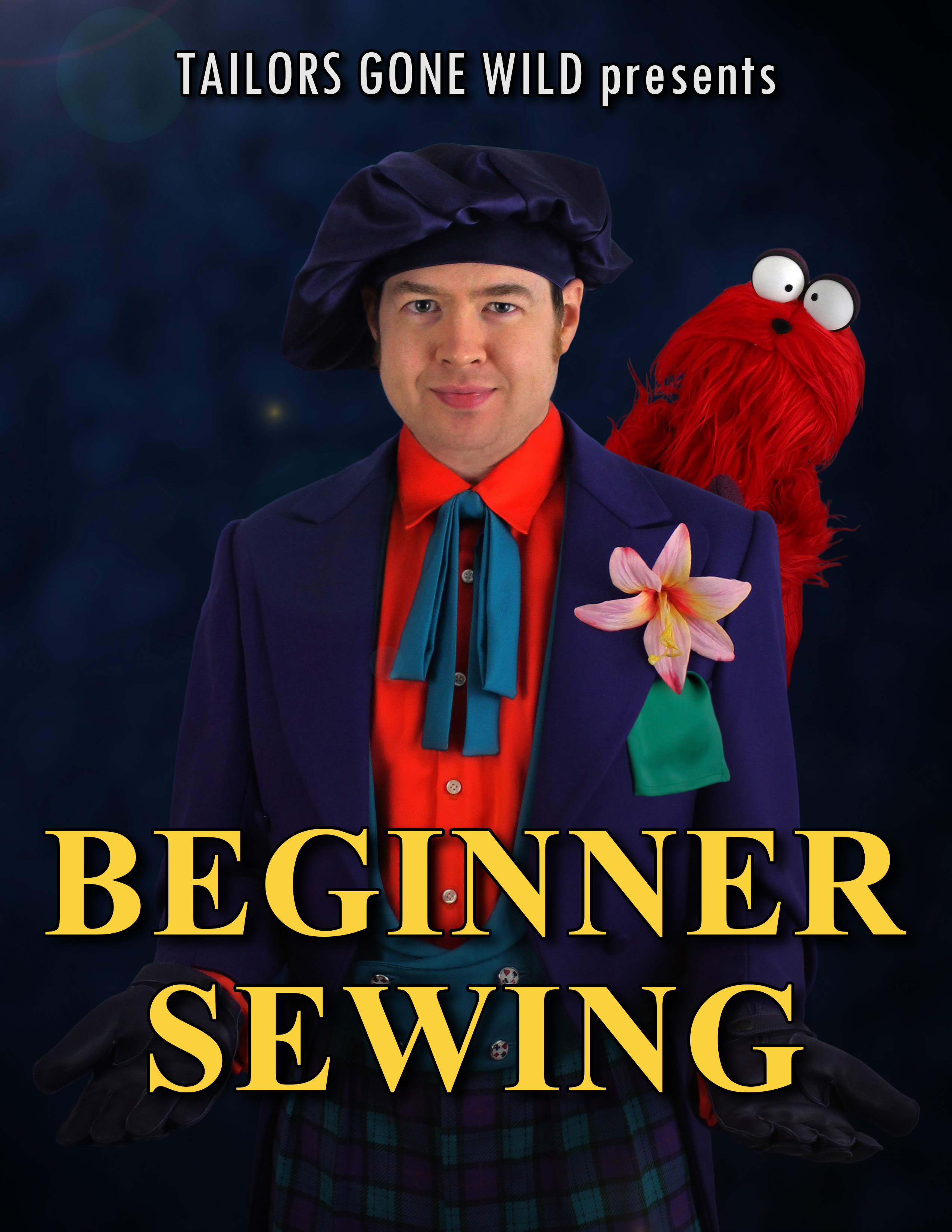
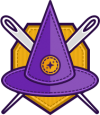
Responses